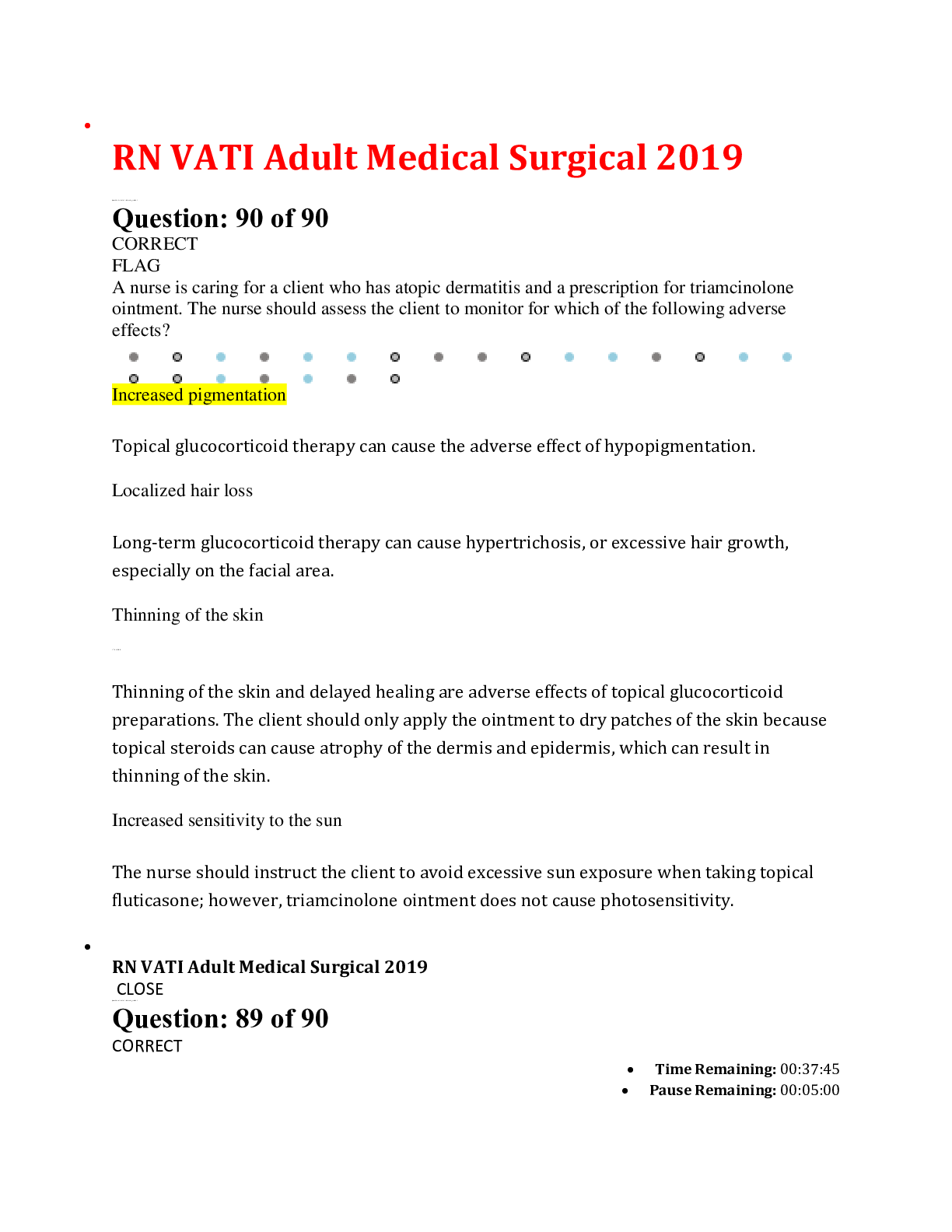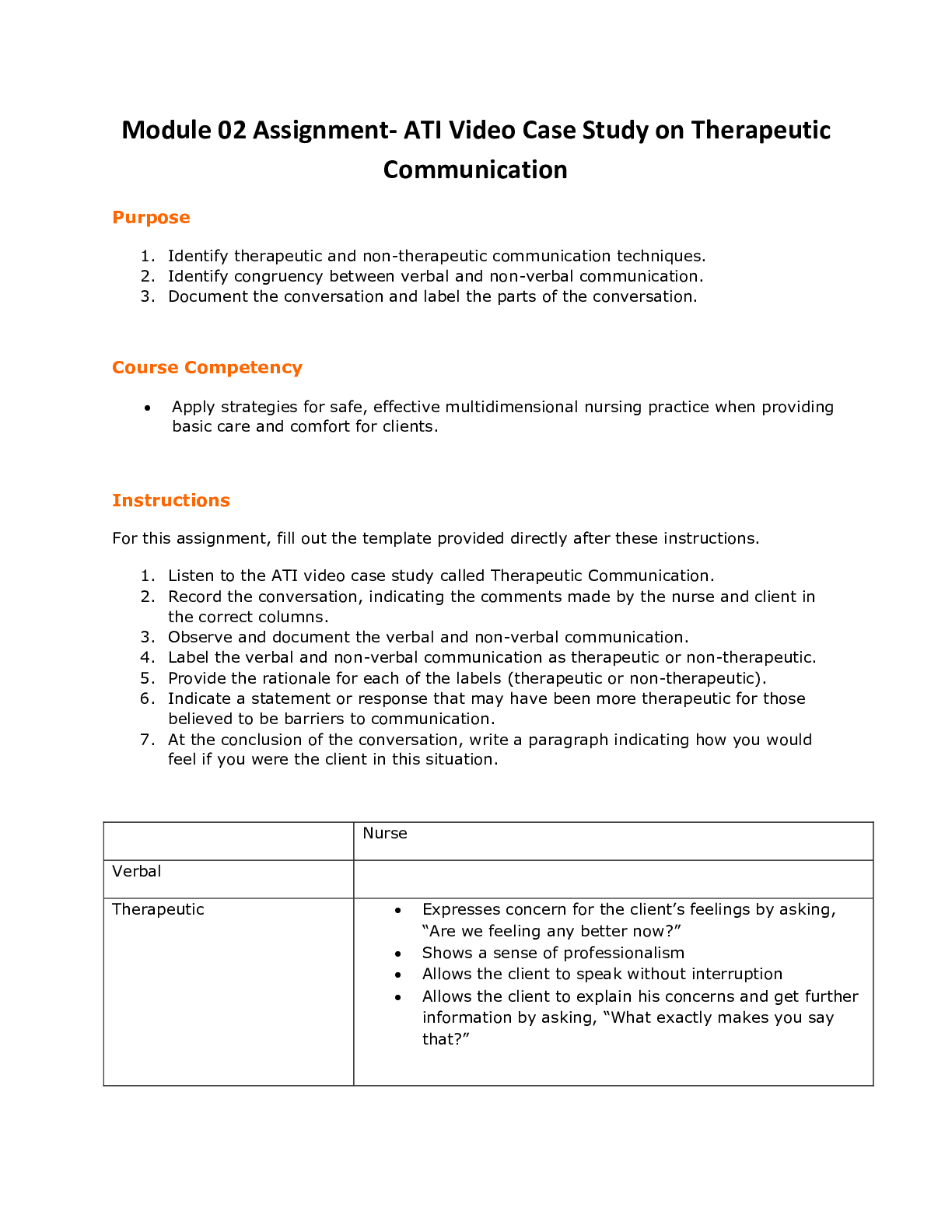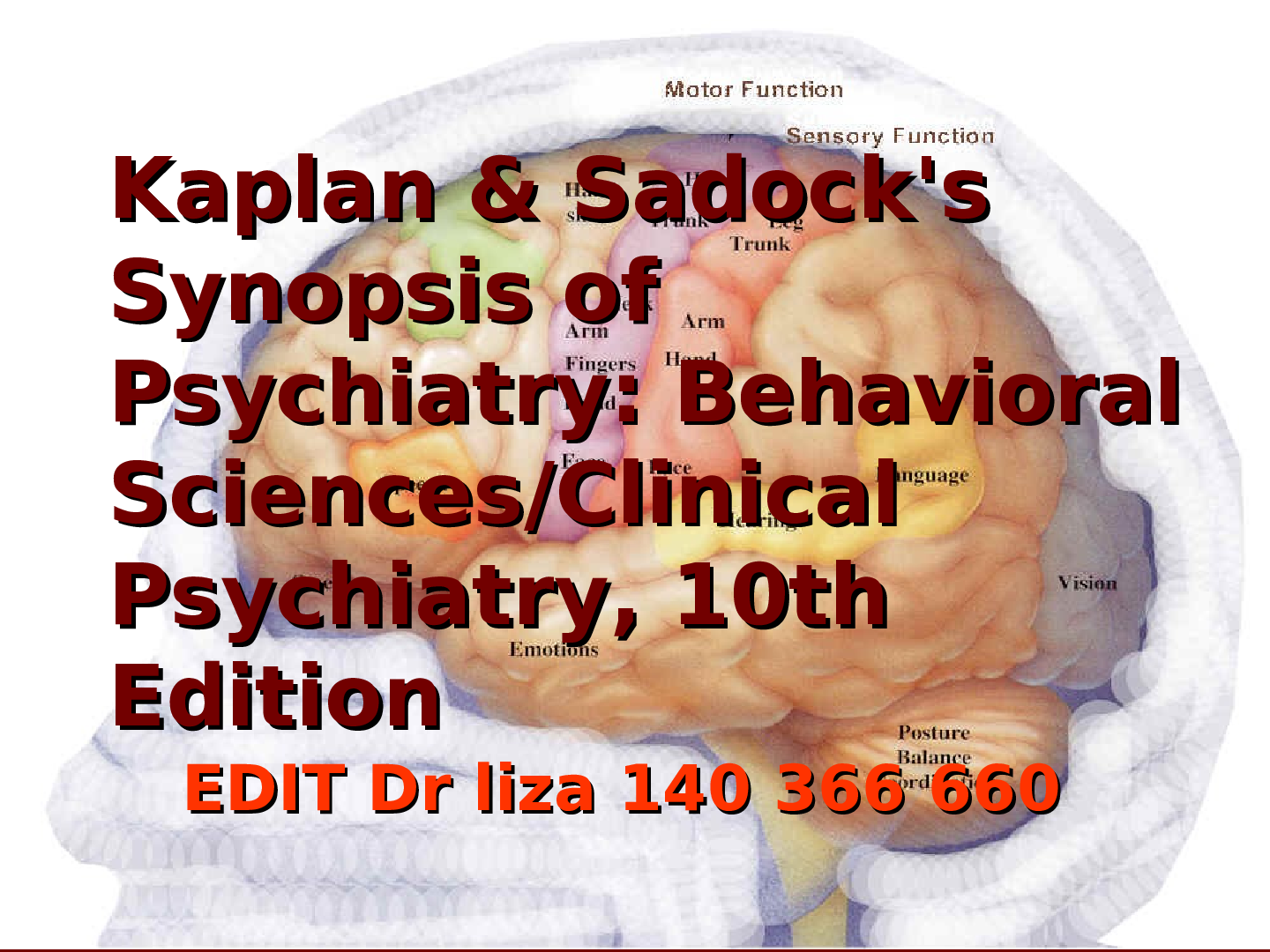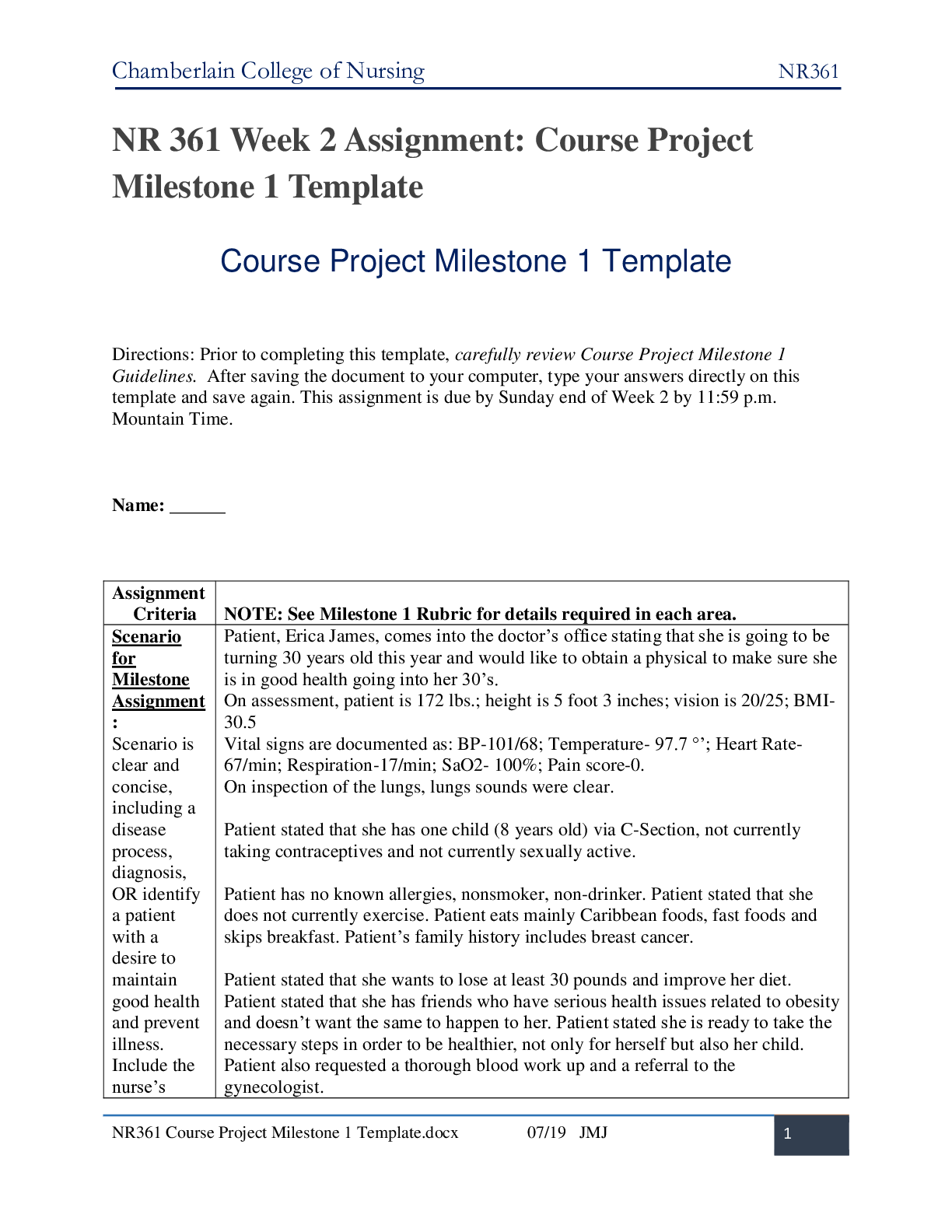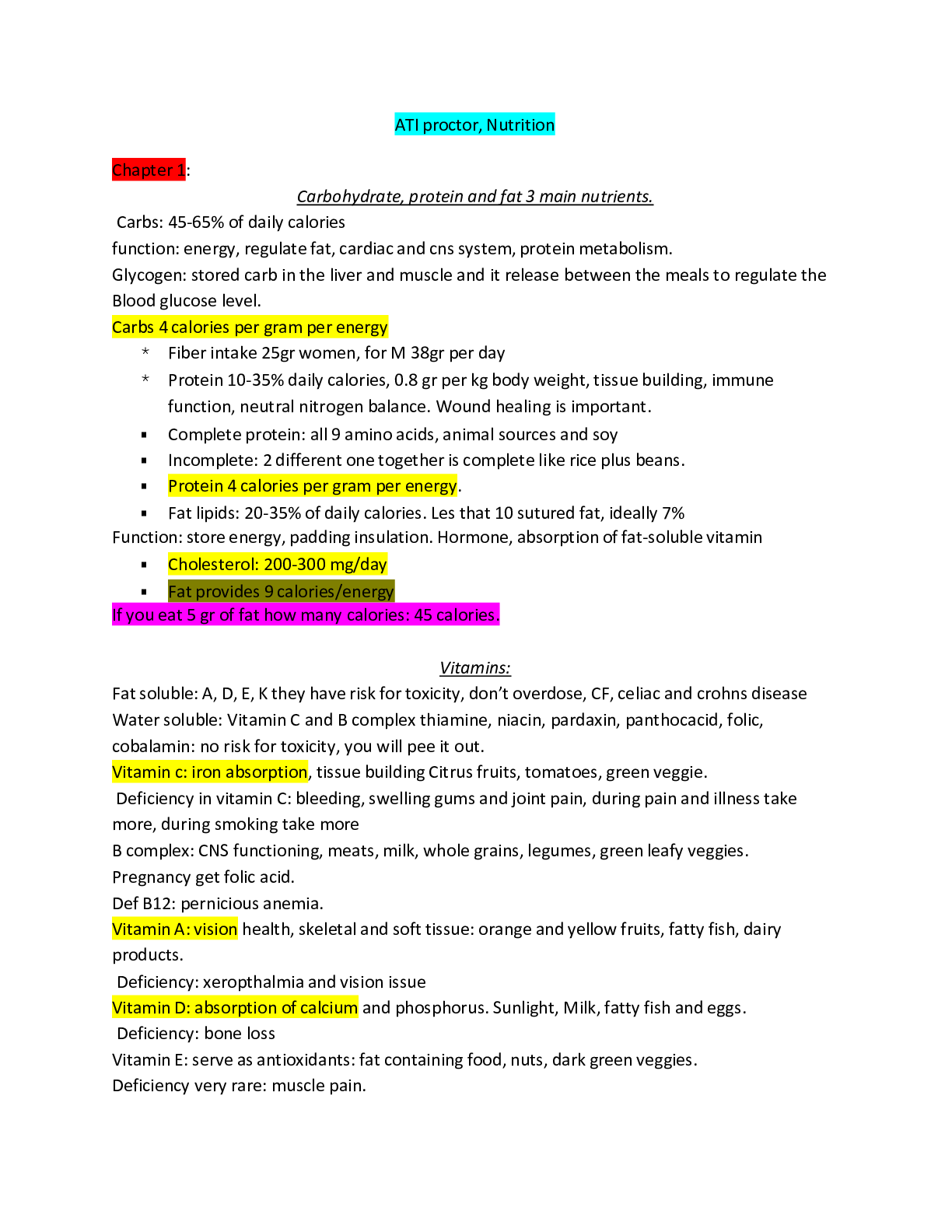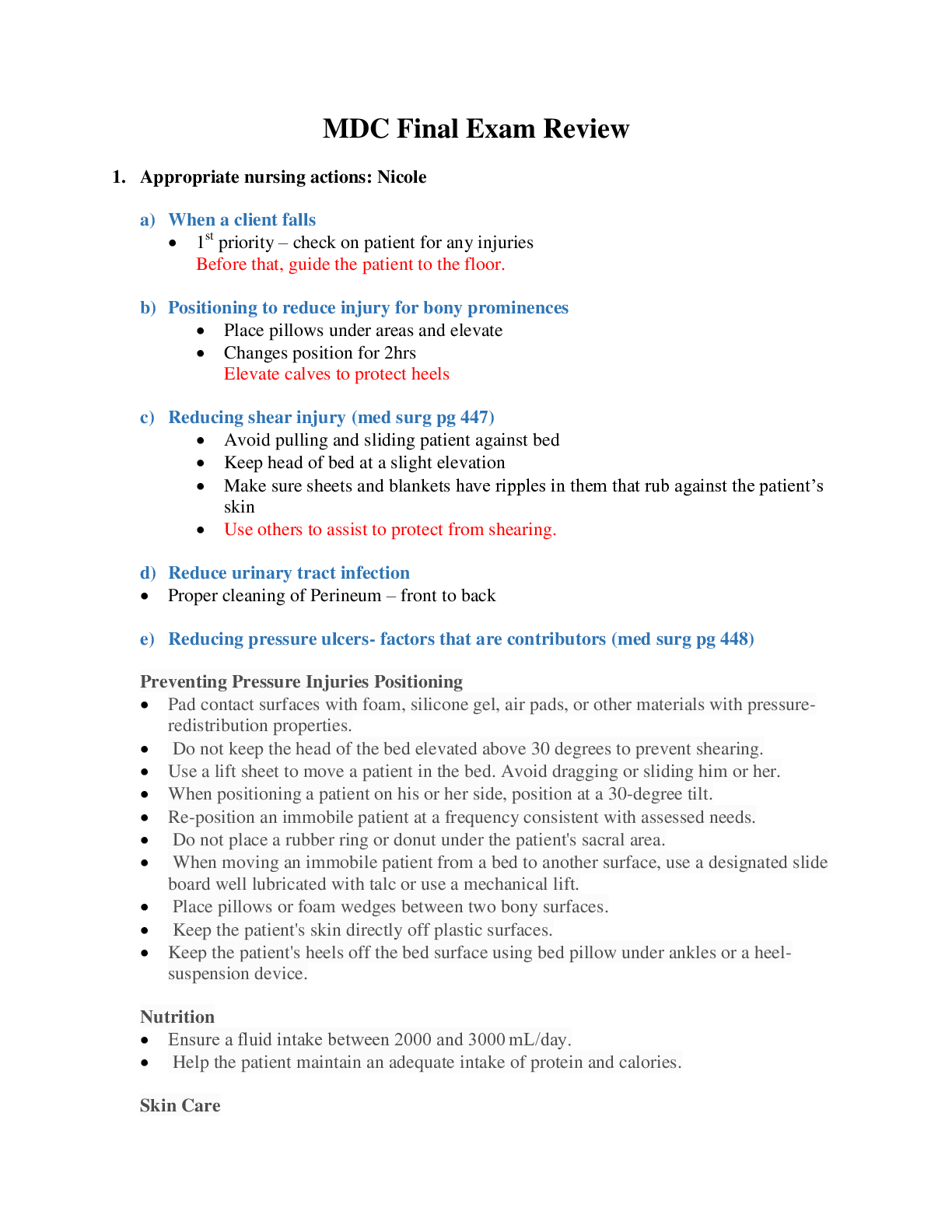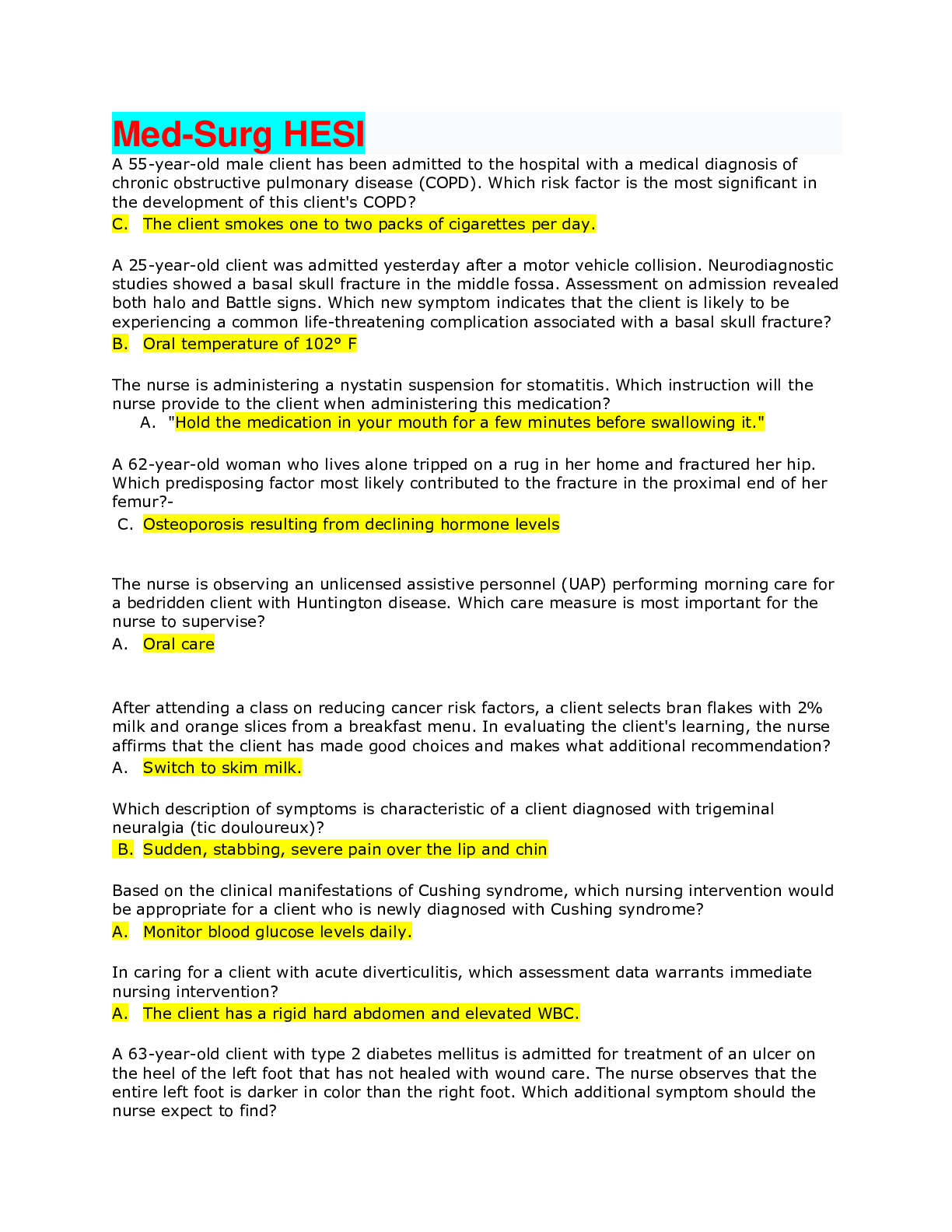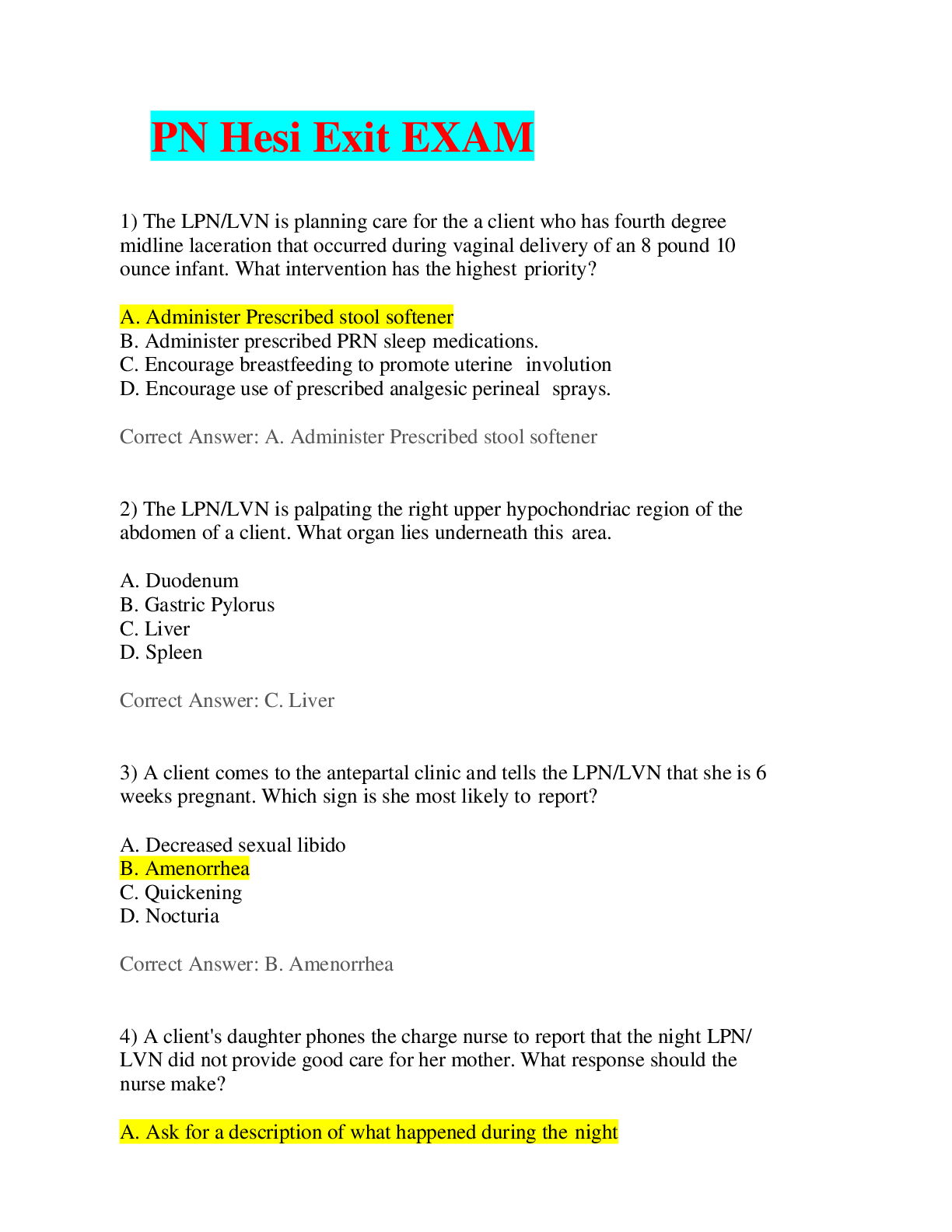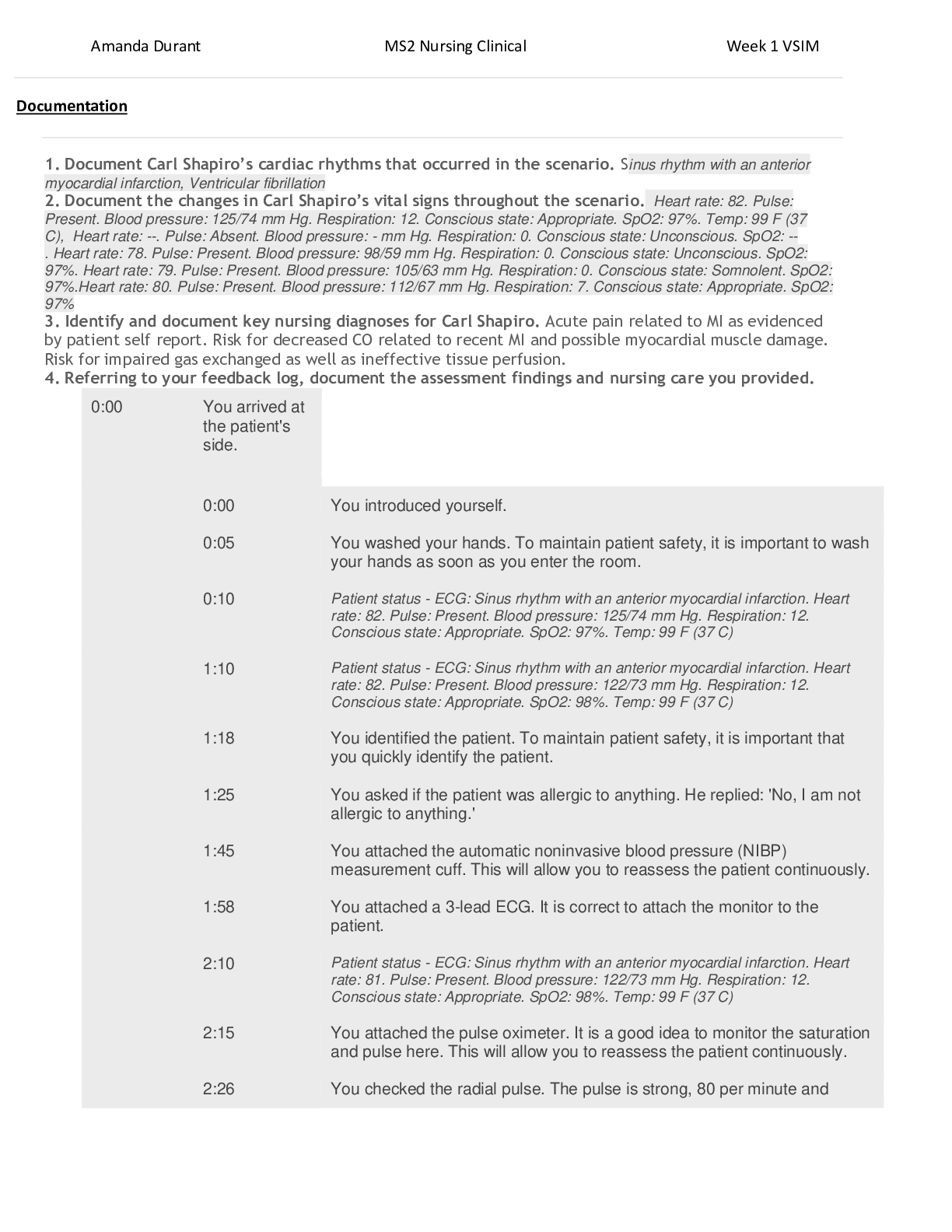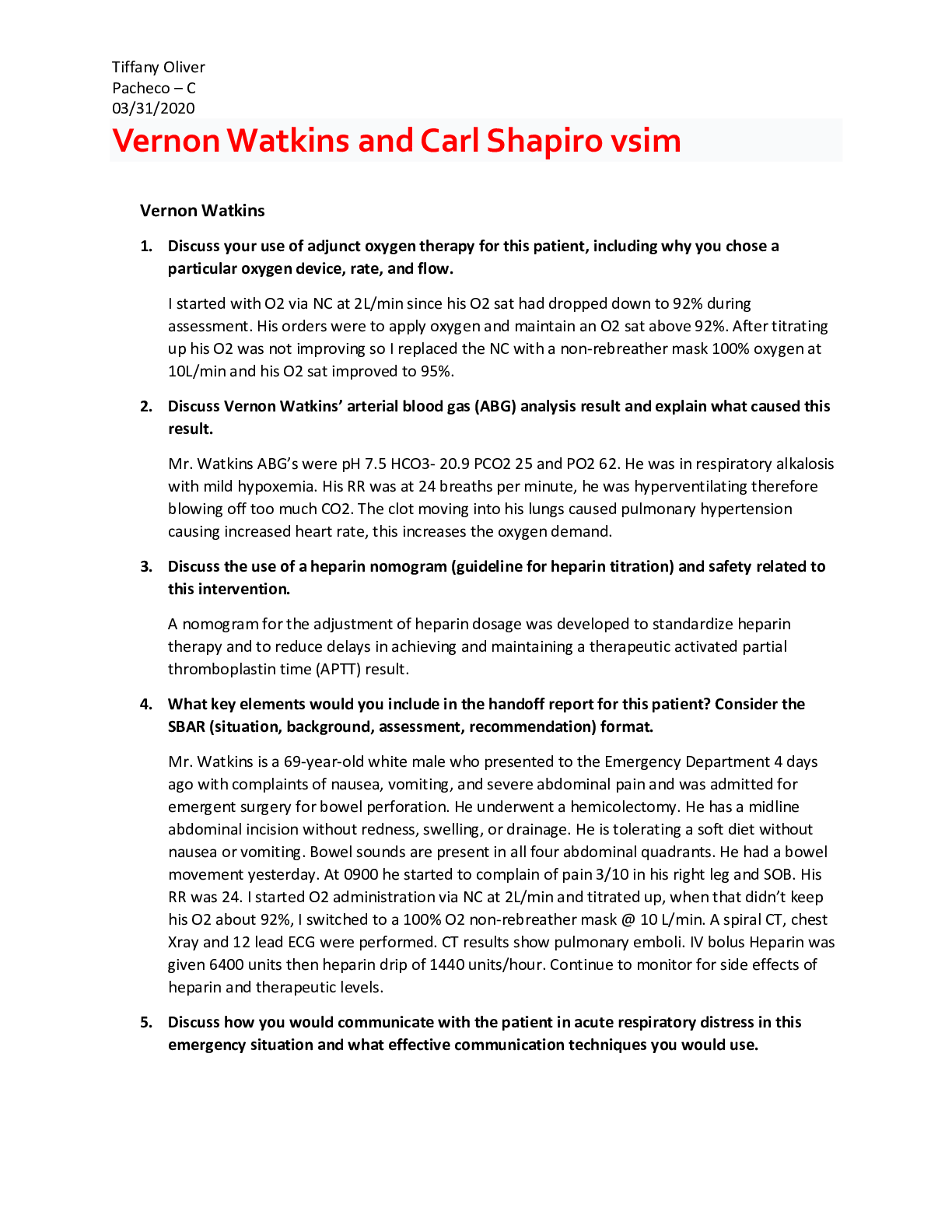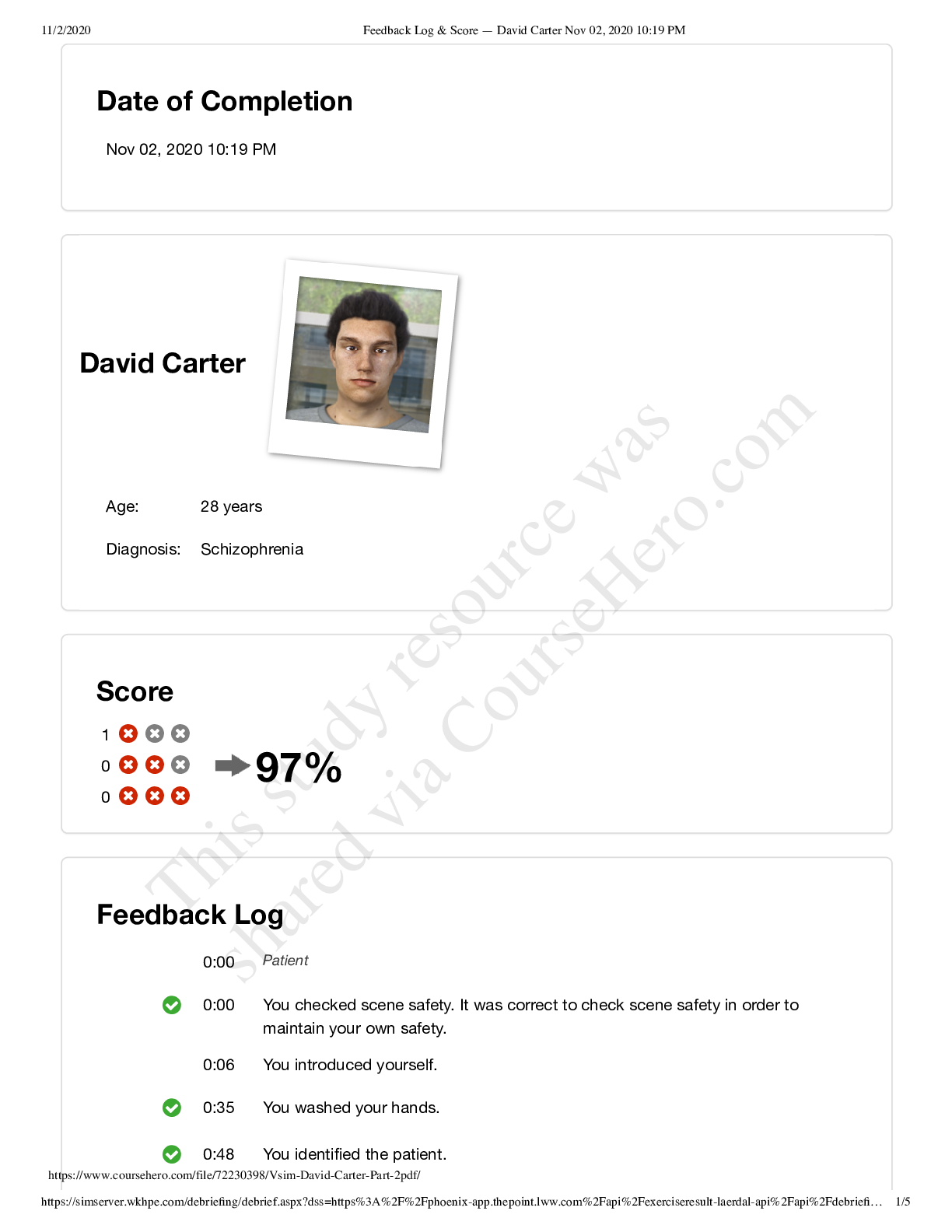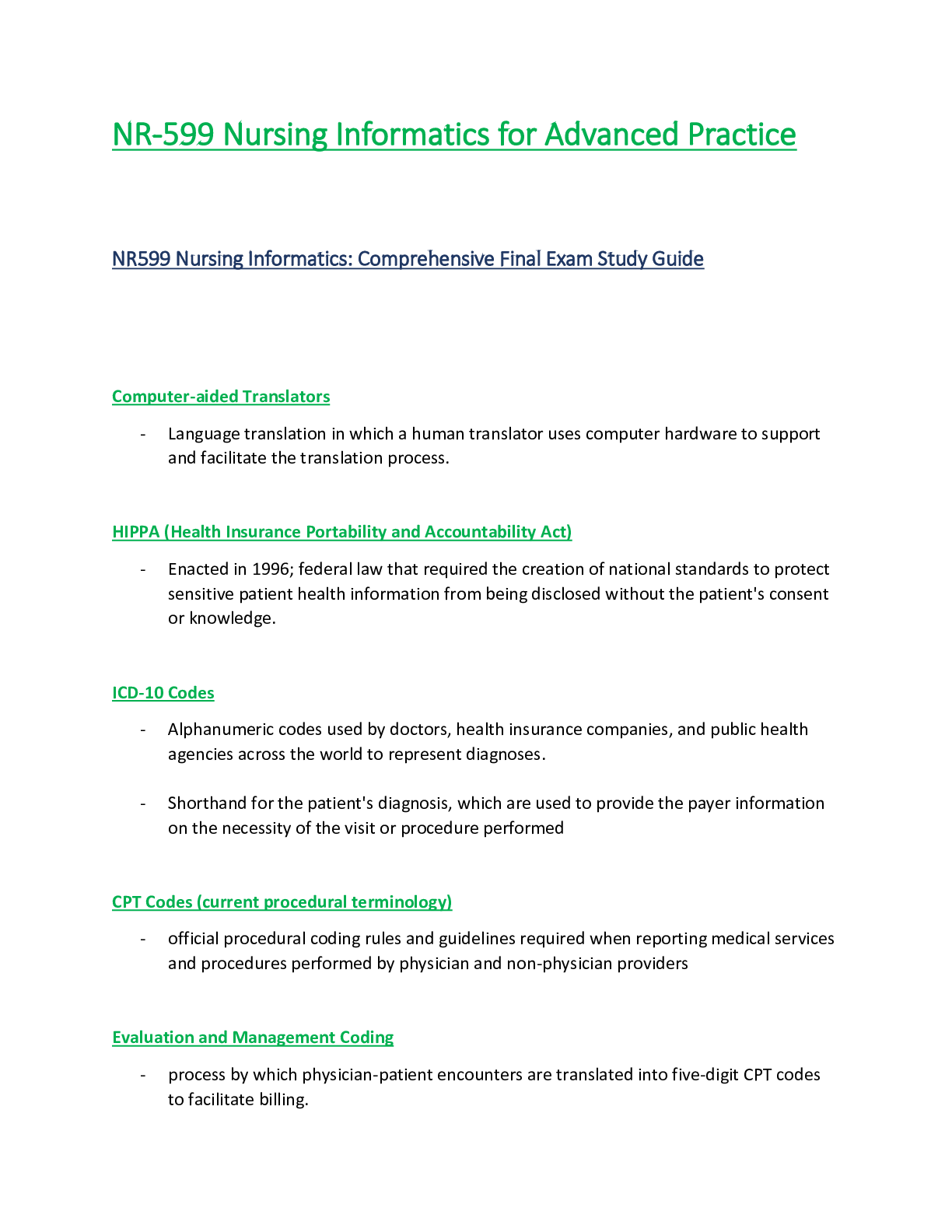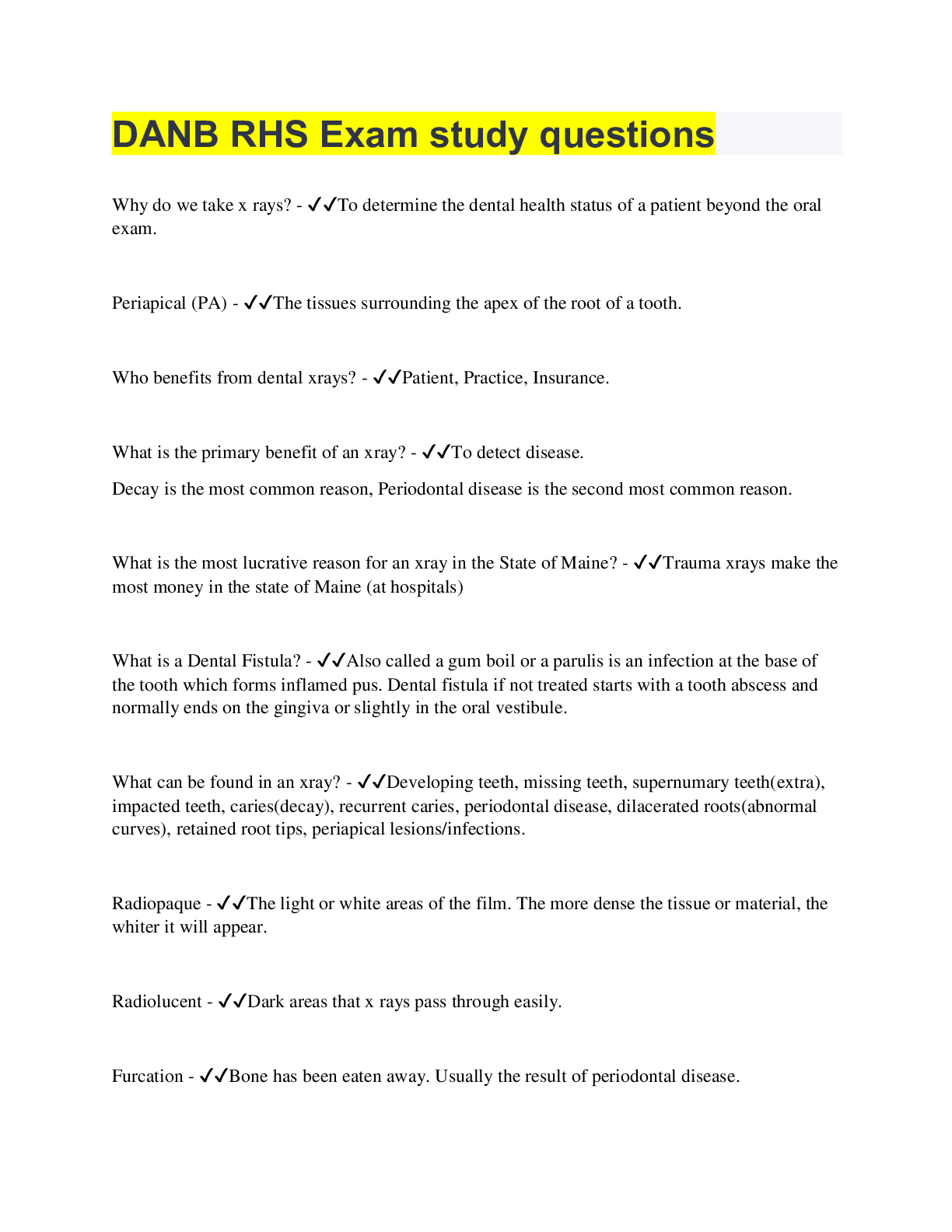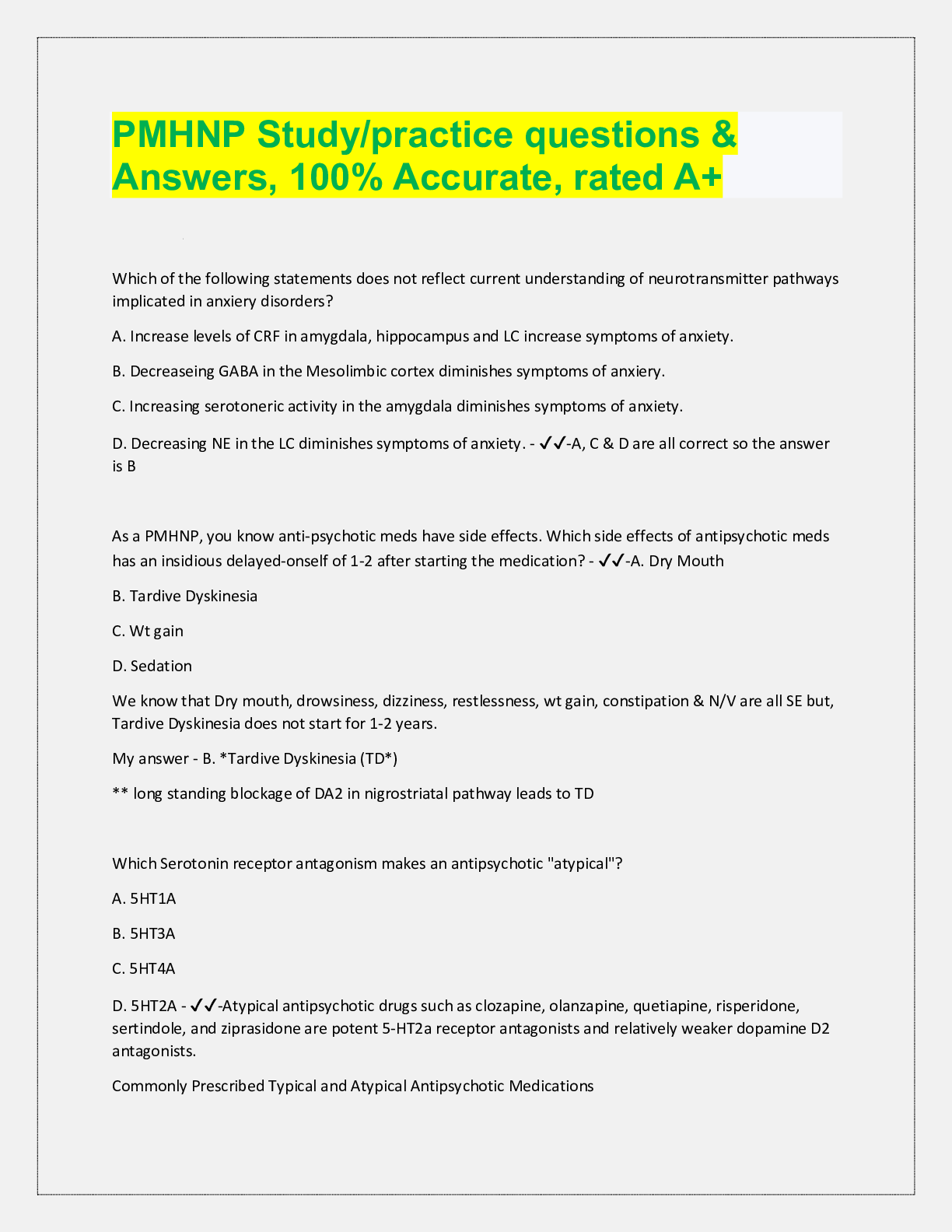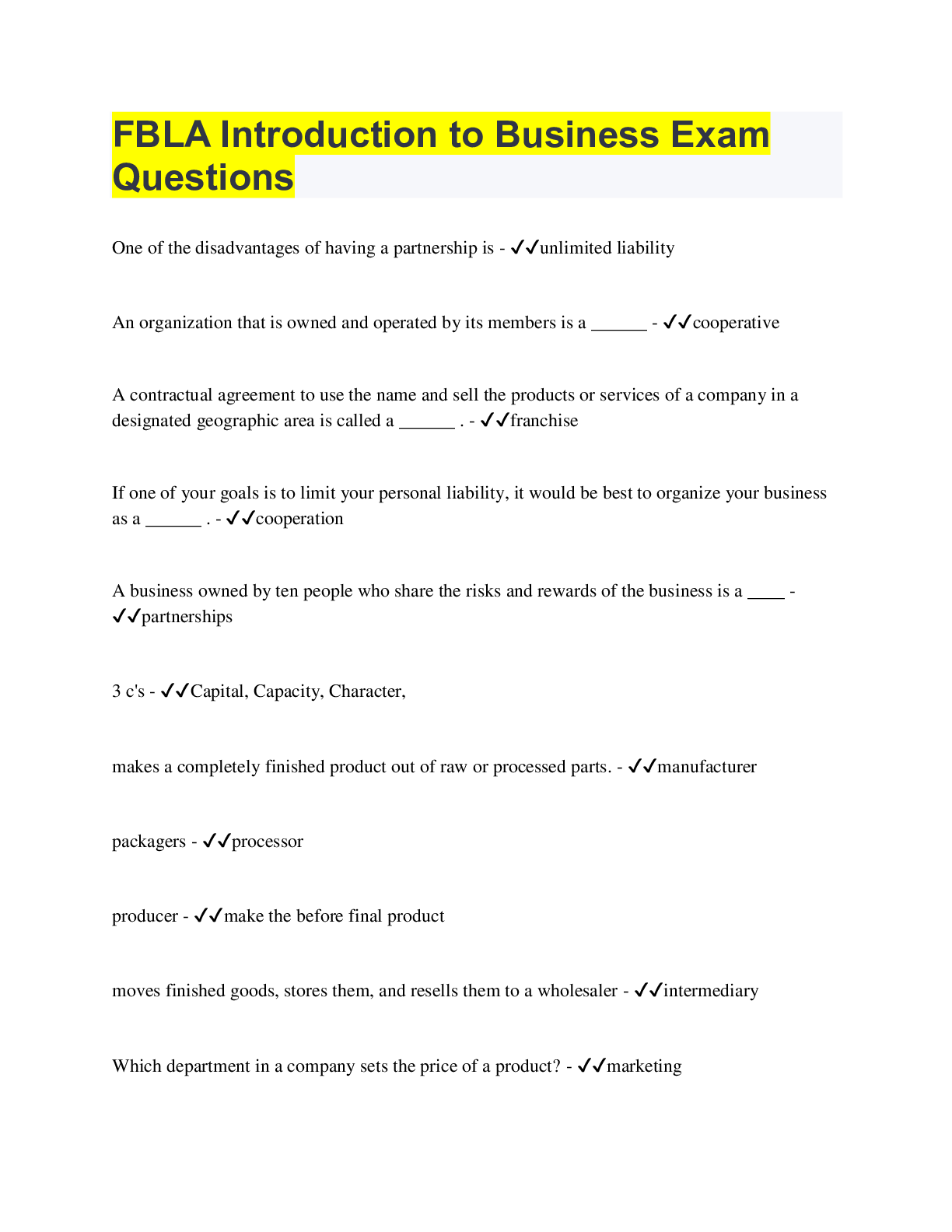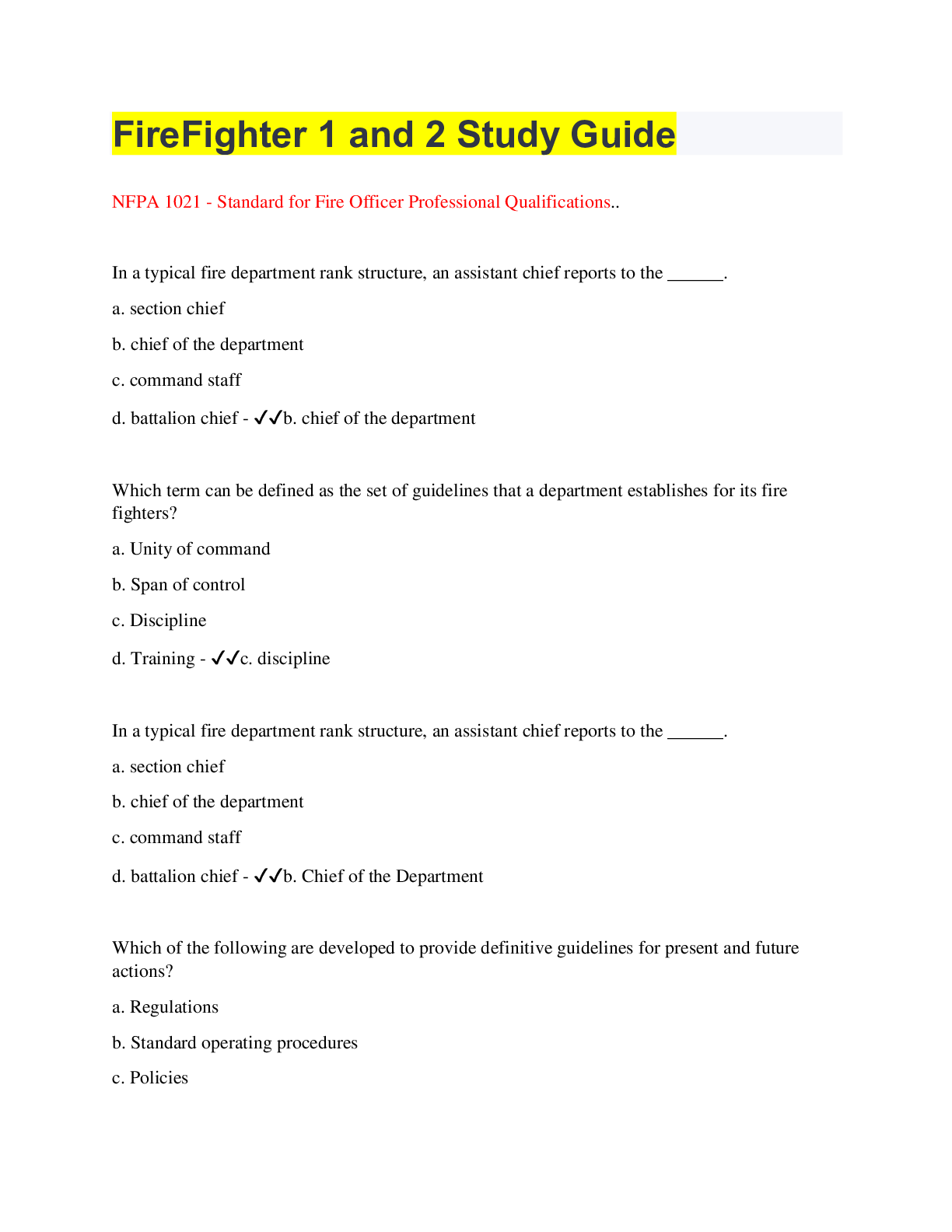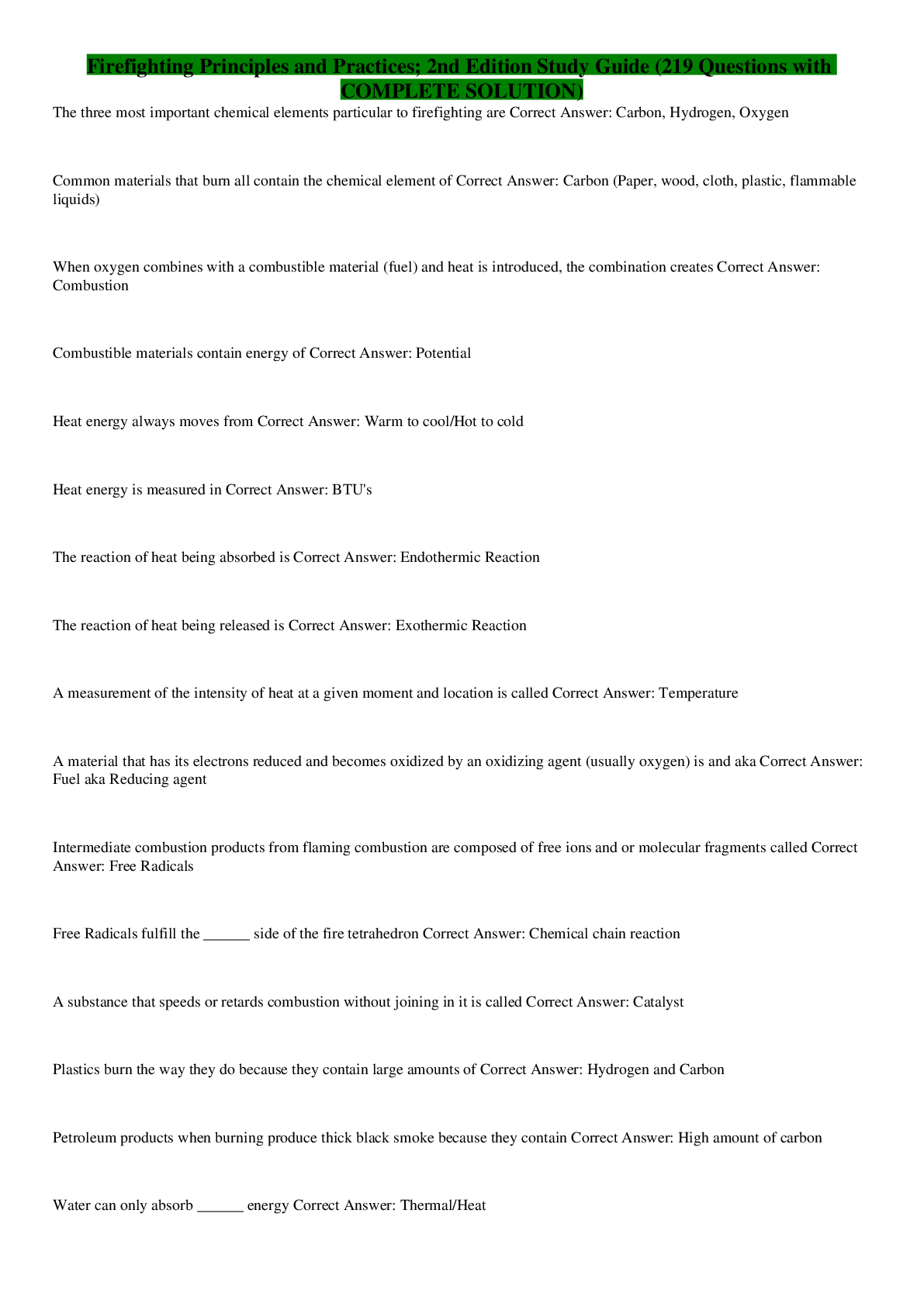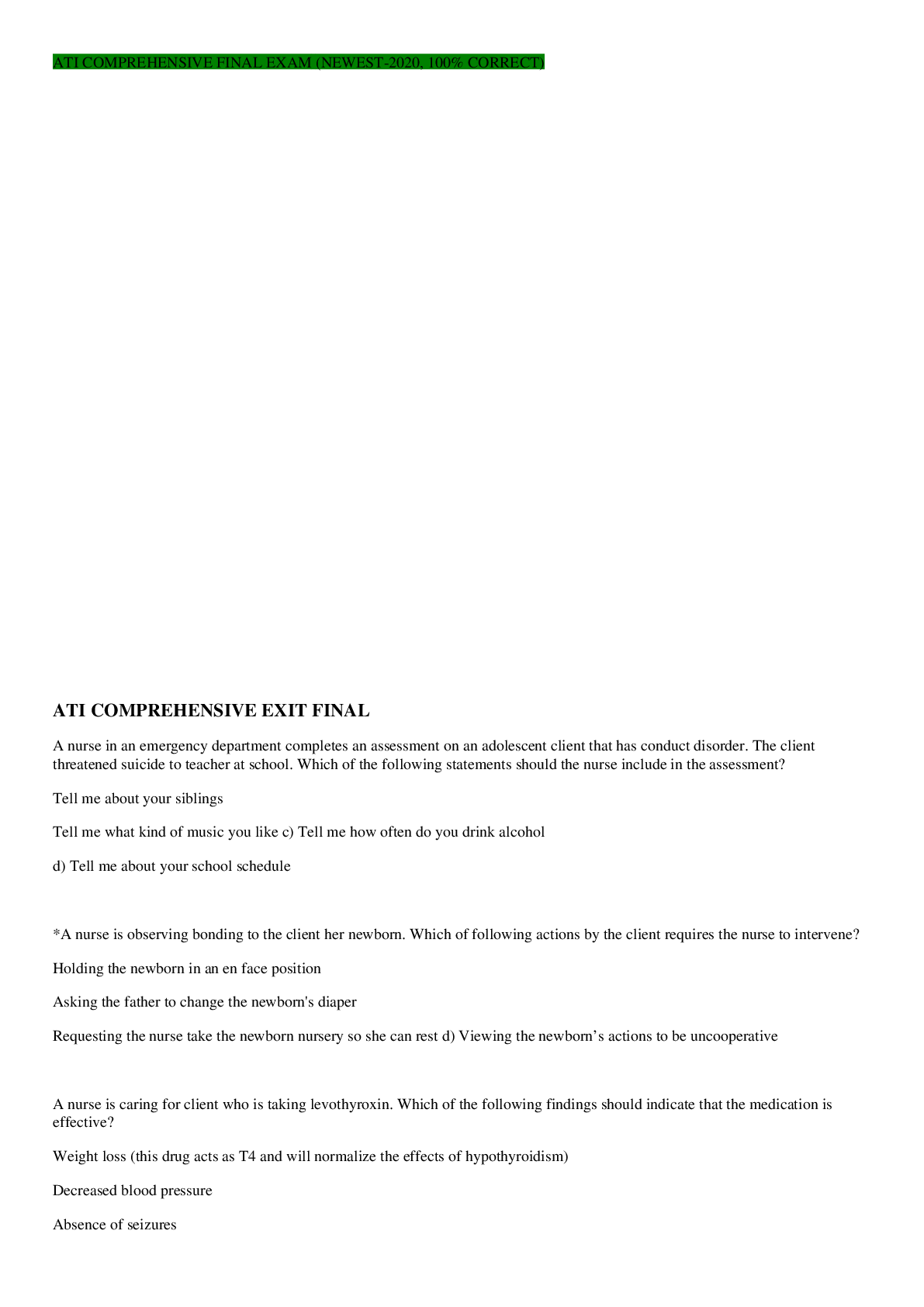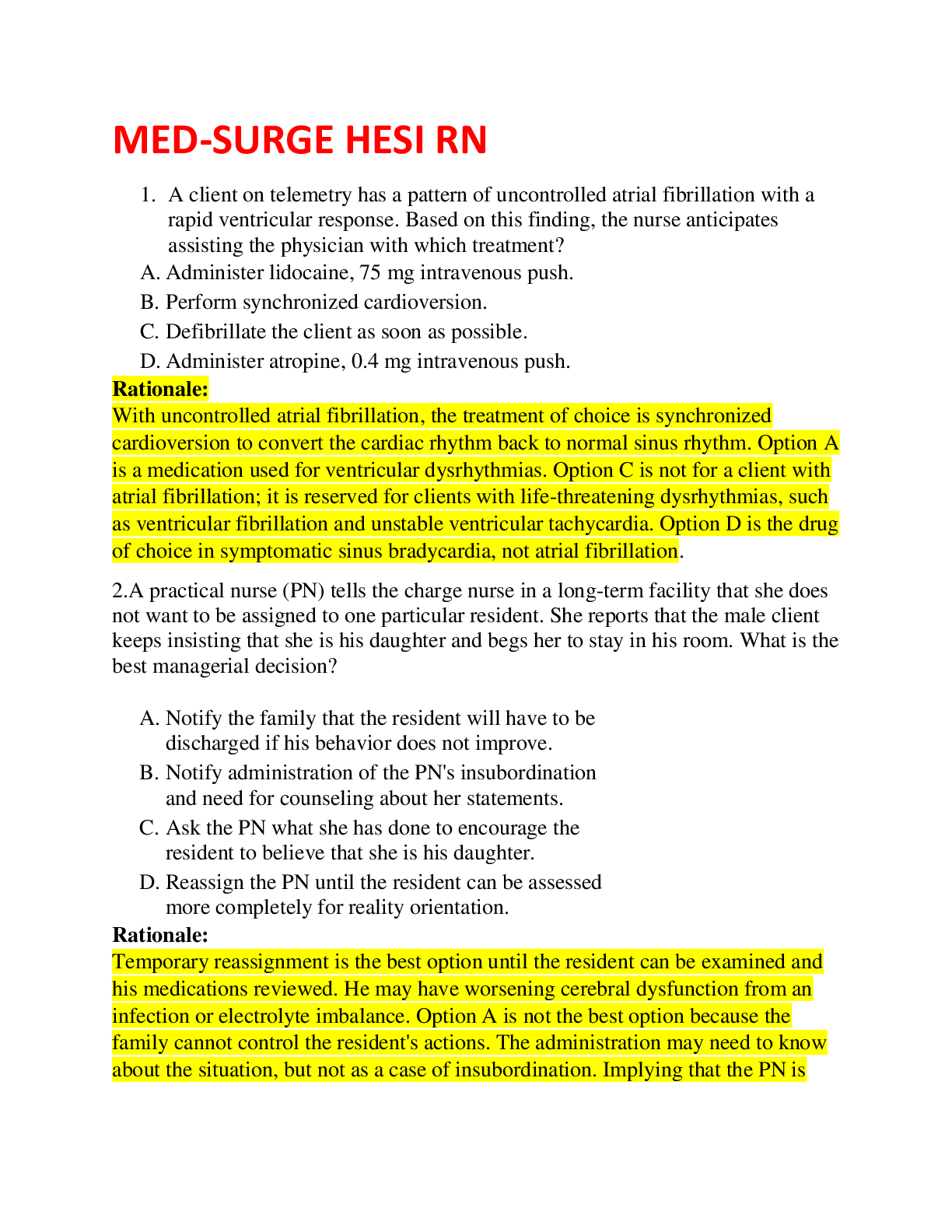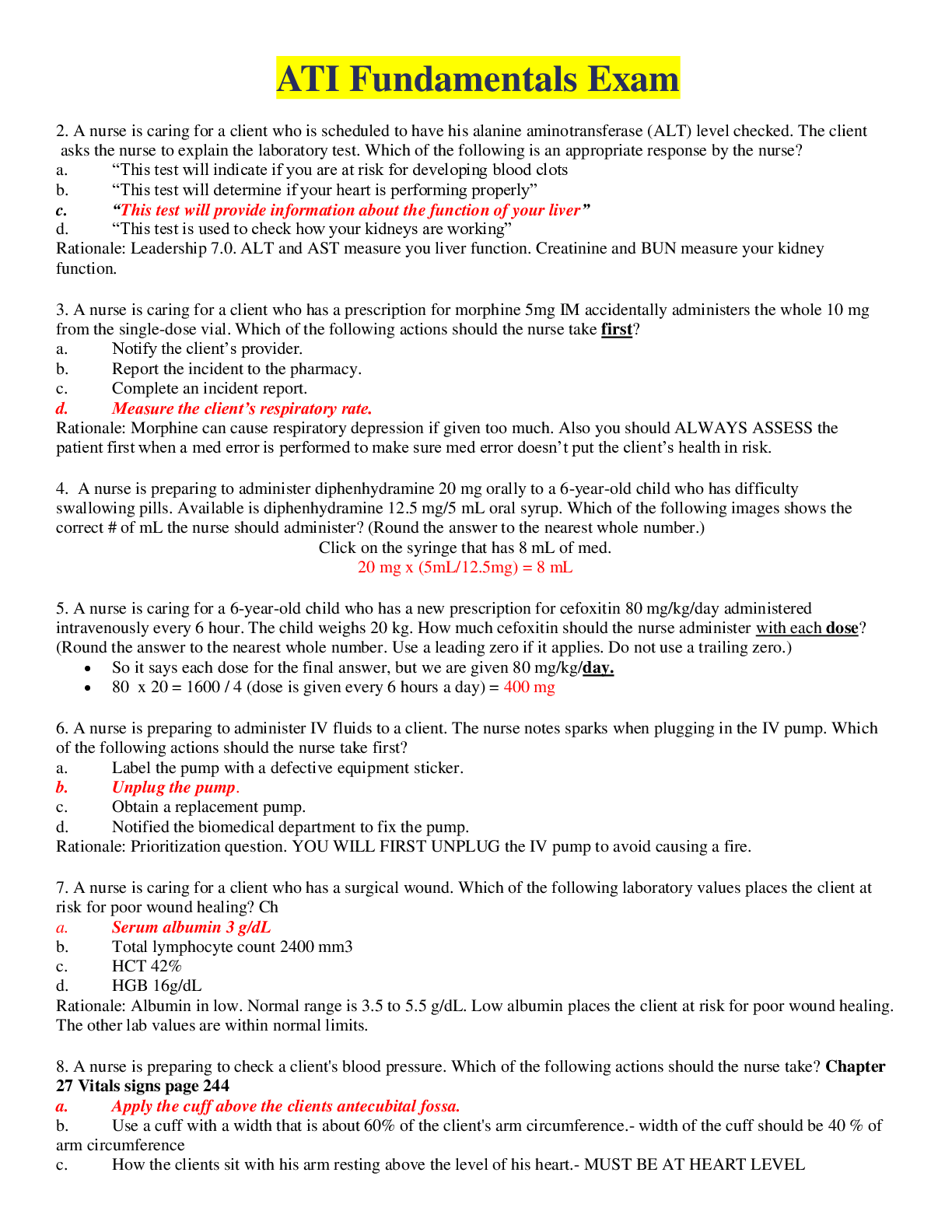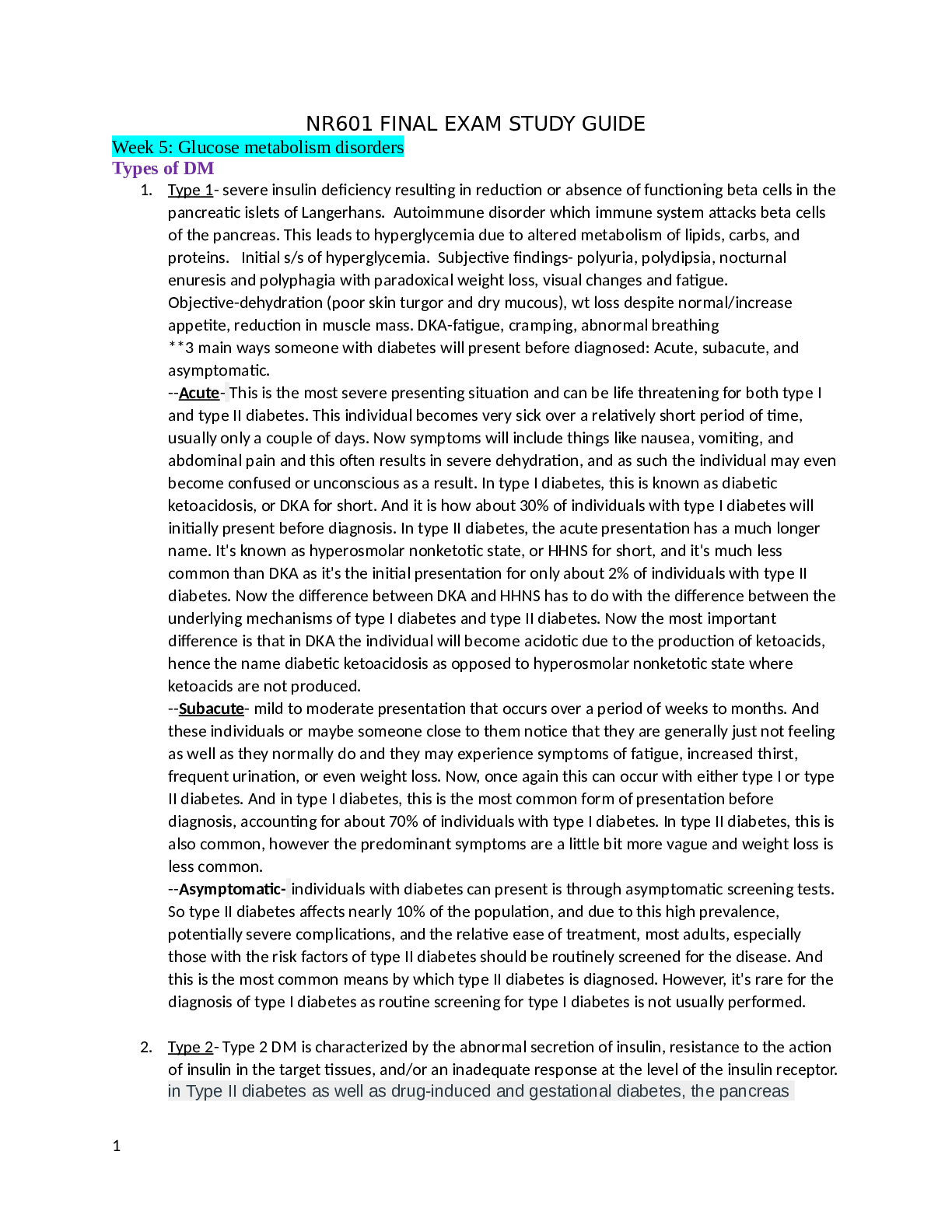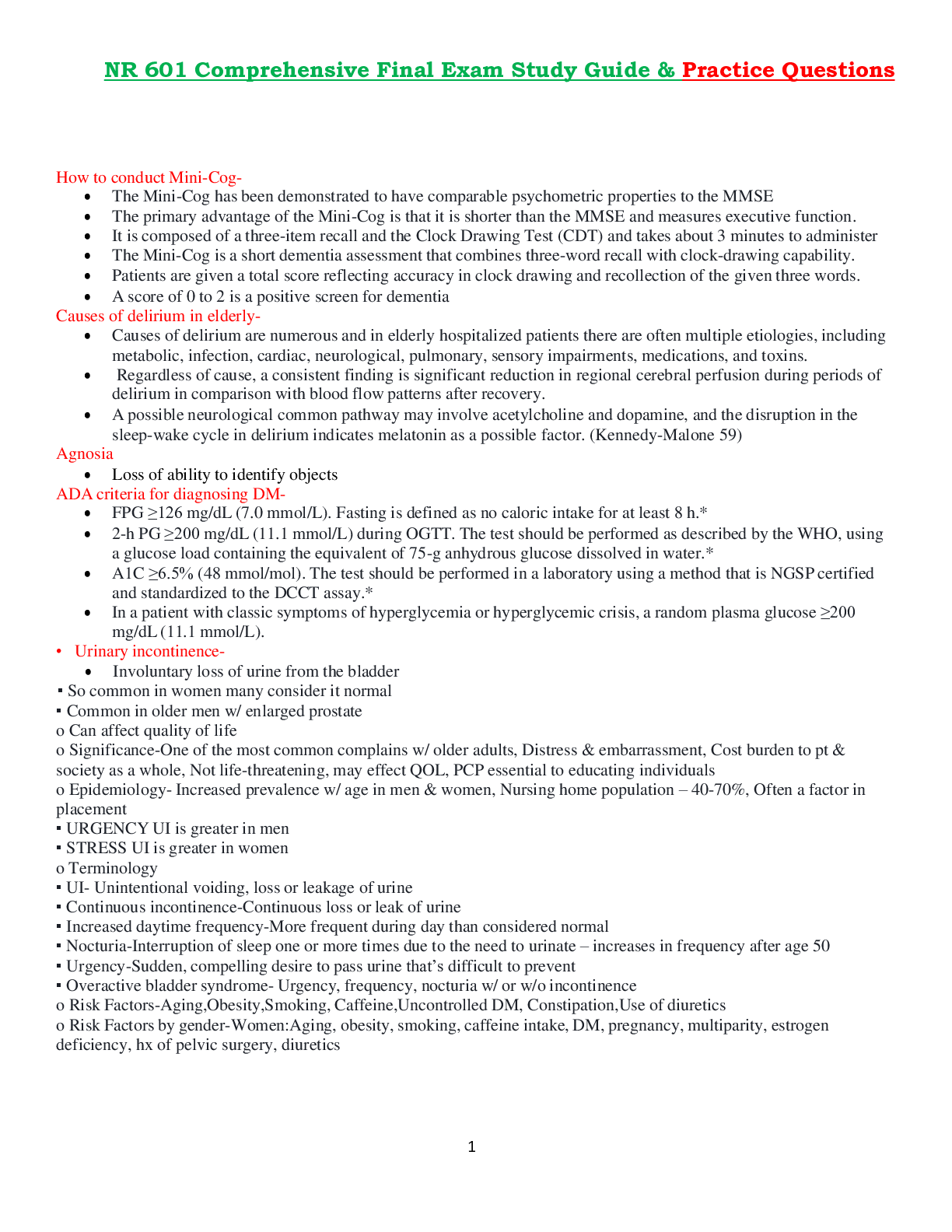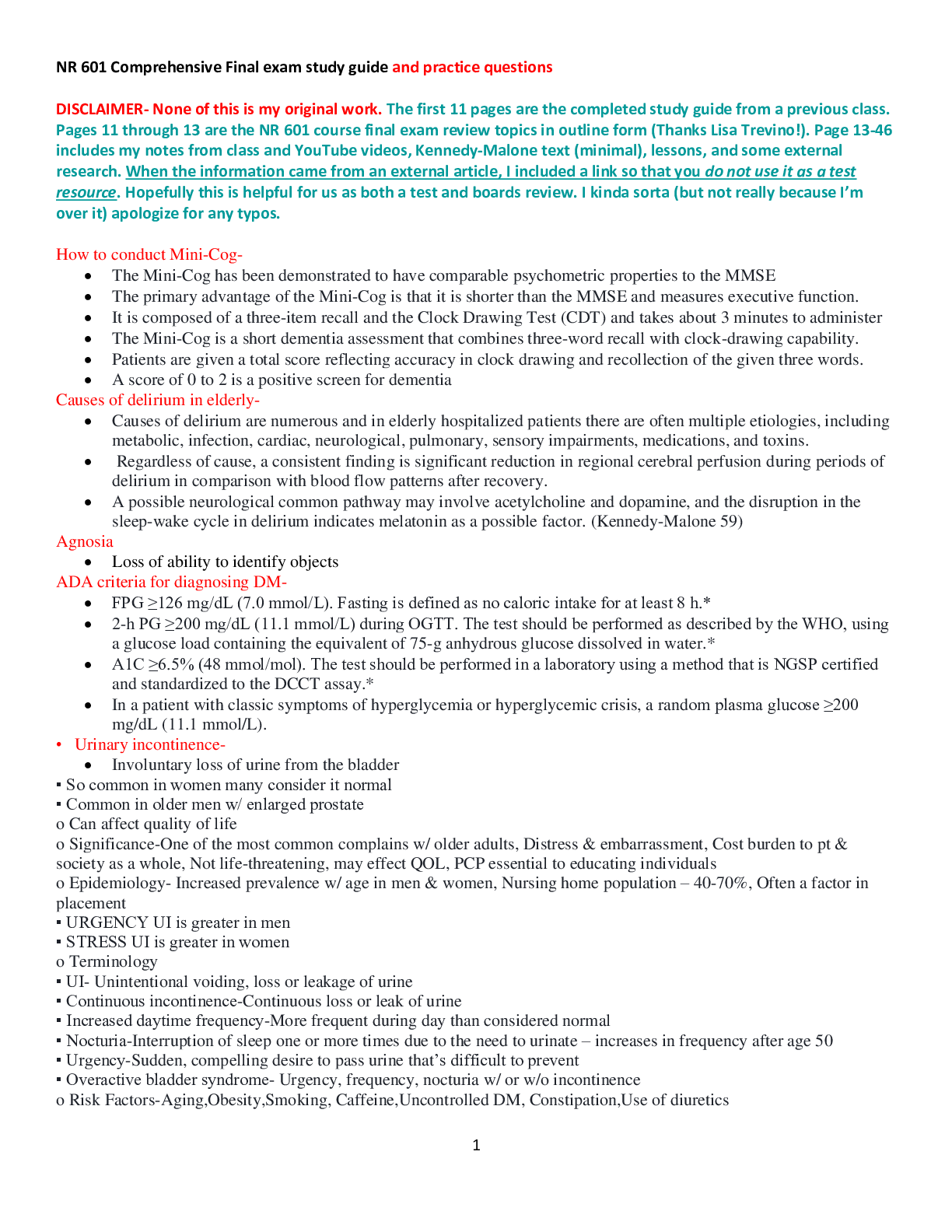*NURSING > STUDY GUIDE > NR 601 Comprehensive Final Exam Review And Practice Questions With Complete And Latest Solutions Gra (All)
NR 601 Comprehensive Final Exam Review And Practice Questions With Complete And Latest Solutions Grade A
Document Content and Description Below
NR 601 Comprehensive Final Exam Review And Practice Questions Question: 6mo ago an elderly pt was dx’d with subclinical hypothyroidism. Today the pt returns and has a TSH of 11 and c/o fatigue. He... has taken Synthroid 25mcg daily as prescribed. What is the best course of action for you?: Question: 48yo female presents for annual exam. A1C is 6.2%. You interpret this result as: Question: 52yo Caucasian woman comes in for annual exam. She has mitral valve prolapse, no symptoms. PE reveals clear/equal breath sounds, midsystolic click. You know her stage of HF is: Question: 55yo Caucasian man follows up w/you after referral to cardio. He reports that he thinks the med is causing a cough and sometimes he has dyspnea. Which of the following meds was most likely prescribed? Question: 55yo Caucasian man w/T2DM presents as new pt. Take metformin 500mg BID. Labs reveal albuminuria and A1C was 7%. He’s current on eye/foot exams. BP today is 136/84. According to 2017 ACC Guidelines, the most appropriate med for his current status is: Question: yo post-menopausal woman with h/o HTN c/o jaw pain on heavy exertion. There were no c/o CP. MGHJKLL Question: 55yo woman presents with somatic complaints. You suspect anxiety. You know that somatic symptoms of anxiety include: Question: 55yo woman w/BMI of 28, has 20yr h/o primary HTN, has been on HCTZ 25mg for years w/excellent response. During this follow up visit, she reports that for the last 6mo she has felt thirsty all of the time even though she drinks at least 10 glasses of water/day. Previous fasting BGL was 136. No further testing was done at that time. You check random BGL now, is 210. What is the next appropriate step? Question: 59yo female c/o pain when she urinates. She has been seen three times for this in the last 3mo. Each time, dx’d with UTI, given abx. She carefully followed instructions, but has no relief of symptoms. Last UA: Question: 59yo woman presents w/following: h/o MI, new onset SOB, especially w/exertion, an occasional rapid fluttering heartbeat and swollen feet. You know this pt’s stage of HF is: Question: 60yo obese male has T2DM and lipid panel of TC 250, HDL 32, LDL 165. You teach the pt about his modifiable cardiac risk factors, which include?: Question: 60yo woman w/30-pack year hx presents for eval of persistent, daily cough w/increased sputum production, worse in the AM, occurring over past 3mo. She says, “I have the same thing year after year.” Which of the following choices would you consider strongly in your critical thinking process? Question: 62yo female c/o fatigue and lack of energy. Constipation has increased and the pt has gained 10lbs in the past 3mo. Depression is denied although she reports lack of interest in usual hobbies. VS are WNL and her skin is dry and cool. Which of the following must be included in the DD?: Question: 62yo male has chronic kidney dz that has been relatively stable. He has h/o hyperlipidemia, OA, HTN. He is compliant w/meds, BP has been well-controlled on a CCB. Last lipids showed TC 201, HDL 40, TG 180, LDL 98. He currently takes Crestor 20mg daily. Today his BP is 188/90 and urine dip shows significant proteinuria. He denies any changes in dietary habits or med regimen. What would be the best med change for him at this point?: Question: 65yo Caucasian female presents with h/o mitral valve stenosis, PE unremarkable. You know the stage of HF is: Question: 65yo female presents to the clinic for the first time and c/o urinary incontinence and dyspareunia. She went through menopause 10yrs ago w/out any hormone replacement therapy and had hysterectomy for a fibroid. Her mom had hip fx at 82. Pt’s most recent mammo was 5yrs ago, no known fam h/o breast ca. She is not taking any meds. Exam is unremarkable except for findings consistent w/atrophic vaginitis. You decide to begin topical hormone replacement therapy. Which of the following evals would be necessary prior to initiating HRT?: Question: 65yo man presents for eval of CP and L-sided shoulder pain, begins after strenuous activity, including walking. Characterized by dull, aching, 8/10 during activity, otherwise 0/10. Began few months ago, intermittent, aggravated by exercise, relieved by rest. Occasional nausea. Pain is retrosternal, radiating to L shoulder, affects QOL by limiting activity. Pain is worse today, did not go away with rest. BP 120/80, HR 72 regular. Normal heart sounds, S1/2, no murmurs. Which of the following diff dx would be most likely? Question: 65yo woman w/BMI 29, 15yr h/o HTN, on HCTZ 25mg for years w/excellent response. Follow up visit: reports that for last 1-2mo, she has been thirsty, increased urination. Last fasting BGL was 118. What action should you take next? Question: 66yo dx’d with acute prostatitis, afebrile w/out severe pain, deemed appropriate to be managed outpt. An appropriate initial treatment option for mild case is: Question: 68yo male, retired Air Force pilot, has been dx’d w/prostate ca in the past wk. He’s never had surgery and seeks clarification on availability of tx’s for prostate ca. He asks you to tell him the SE of radical prostatectomy. Which of the following is NOT a potential SE of this procedure?: Selected low back pain Question: 68yo man presents for physical, has had T2DM x5yrs, diet controlled. BMI 32. H/o HTN, smoker 10cigs/day x20yrs. Fam h/o CAD, CABG x4 for father, now deceased; CHF, T2DM, HTN for mother. He is asymptomatic today, exam is normal, EKG NSR. According to AHA/ACC guidelines, he is at risk for what stage of HF? Question: 72yo female has been dx’d w/gout. She also has a long h/o chronic HF. The most likely contributing factor to development of gout in this pt is:: Question: 72yo woman and husband are on cross-country driving vacation. After long day of driving, they stop for dinner. Midway through meal, she gets very SOB, w/CP and a feeling of panic. Which of the following problems is most likely?: Question: 76yo man seen for c/o UI. You should explore which of these causes of UI in men? Question: 77yo Caucasian female has h/o breast ca. She’s been in remission for 6yrs. As her PCP, you are seeing her for follow up of her recent c/o intermittent abd pain x3mo and general malaise. Given the hx above, what will you direct your assessment at during the exam?: Question: 78yo female presents w/sz that occurred over the weekend. In selecting the most important diagnostics for this presentation, it is important to know that the least common site of sz’s in the elderly is:: Question: 78yo man w/PD is being care for in a nursing home. The nurses observe that he coughs at mealtime; he has the ability to feed himself w/adaptive equipment. He has had no aspirations. Oral exam is normal, except during swallow eval you note there is slight delayed elicitation. You assess that he has only mild dysphagia. You recommend which of the following as the next step in his care?: Question: 79yo man is being eval’d for frequent urinary dribbling w/out burning. Physical exam reveals smooth but slightly enlarged prostate. His PSA is 3.3. He undergoes formal urodynamic studies and findings are as follows: decreased bladder capacity of 370mL, few involuntary detrusor contractions at a low bladder volume of 246mL, increased postvoid residual urine volume of 225mL, and slightly decreased urinary flow rate. Which of the following is not consistent with normal age-associated change?: Question: 87yo female has been taking 100mcg of Synthroid x10yrs. She comes to your office for routine follow-up, feeling well. Her HR is 90. Your first response is to:: Order TSH 2017 HTN guidelines categorize a healthy 54yo African American woman with a BMI of 23 and consistent BP readings of 120-128/76-78 as: Question: You are reviewing a pt chart before the exam. You note that the pt is using topical capsaicin. You know that topical capsaicin is often used for tx of: Question: Acanthosis Nigricans is associated with all of the following except: Question: ACC 2017 guidelines for high BP in adults, adults w/stage 1 HTN and high ASCVD risk should be managed w/both nonpharm and antihypertensive drug therapy. You know the pt should return for a follow up appointment which includes BP check in: Question: ACC 2017 Guidelines for High BP in adults discusses screening/management of other CVD risk factors for hypertensive pts. According to the guideline, basic testing for primary HTN includes fasting BGL, CBC, lipids, BMP, TSH, UA, EKG w/optional echo, uric acid, and urinary albumin-to-creatinine ratio. Question: According to 2017 ACC HTN guidelines, normal BP is: Question: According to 2017 ACC HTN guidelines, the recommended BP goal for 65yo African American woman w/a h/o HTN and DM and no h/o chronic kidney dz is: Question: According to 2017 Guidelines for HTN in adults, recommended BP goal for 68yo Asian American woman w/no h/o DM and a h/o CKD is: Question: According to ADA guidelines, which of the following are appropriate screening tests for T2DM? Question: According to the GU presentation, #1 risk factor for urinary incontinence is: Question: A drug that can be used to treat two very common symptoms in a dying pt (pain and dyspnea) is:: Question: A fluoroquinolone (Cipro) is prescribed for a male pt w/a UTI. What should you teach the pt regarding taking this med?: Question: A form of syncope that is more common in elderly than younger adults is:: Question: Age-related changes in the bladder, urethra, and ureters include all of the following in older women except:: Question: Aging process causes what normal physiological changes in the heart? Question: A key symptoms of ischemic heart dz is CP. However, angina equivalents may include exertional dyspnea. Angina equivalents are important because:: Question: Ali is 72yo man who recently came to US from Nigeria. He reports having BCG (bacille Calmette-Guerin) vaccinations as a child. Which of the following is correct regarding TB skin test?: Question: All of the following antimicrobials may be indicated in chronic bacterial prostatitis except:: Question: All of the following are considered as contributors to dysphagia except:: Question: All of the following are true about lab values in older adults except: Question: All of the following may be reasons associated w/an elevated PSA besides prostate ca except:: Question: All of the following pts have a risk of adverse reaction from Metformin except: Question: Question: All of the following statements about tremor are true except:: Question: All of the following statements are false about drug absorption except: Question: All of the following statements are true about drug absorption in the elderly except: Question: All of the following statements are true about interventions in working w/the bereaved except:: Question: All of the following statements are true regarding anxiety except: Question: Anal wink reflex is used to test:: Question: An effective exercise therapy for RA is: Question: An elderly nursing home pt is maintained on phenytoin tx for h/o sz. In addition to periodic serum drug concentrations, which of the following are needed for annual eval?: Question: An elderly pt has had a CVA in the anterior cerebral circulatory system (frontal lobe). What symptoms are most likely expressed?: Question: An elderly pt presents w/a new onset of feeling heart race and fatigue. EKG reveals afib w/rate >100. Pt also has a newfound tremor in both hands. Which of the following would you suspect?: Question: An example of secondary prevention you could recommend/order for elderly would be to: Question: An older adult female pt had a stroke. What symptoms are not usually expressed by pt’s who have had a vertebrobasilar stroke?: Question: An older adult w/a h/o sz disorder comes into the clinic for routine checkup. Although sz-free, the pt continues on long-term phenytoin tx. You would assess for which of the following long-term effects?: Question: An older male pt is experiencing acute onset of R-sided weakness, slurred speech, and confusion. What should you do promptly?: Question: Aortic regurgitation requires medical tx for early s/s of HF with: A pelvic mass in a post-menopausal woman:: Question: Atypical presentation of acute coronary syndrome is:: Question: Atypical presentation of dz in elderly is reflected by all of the following except: Question: Beers criteria are appropriate for use in evaluating use of certain meds in pts: Question: Best method of verifying a dx of gout in a joint is:: Question: Best recommendation for pt who state they have no equipment to exercise would be:: Question: Best way to diagnose structural heart dz non-invasively is: Question: Biochemical individuality is best described as:: Question: Bordetella pertussis is best characterized by:: Question: CC, 62yo male, new to your practice. Previously dx’d w/Stage B HF. According to week 2 HF lecture, you’ll look for the following med classes to ensure appropriate tx of HF: Question: Chronic fatigue syndrome is best described as:: Question: Chronic pain can have major impact on pt’s ability to function and have profound impact on overall QOL. Ongoing pain may be linked to: Question: Common auscultatory finding in CHF is:: Question: Consistent finding in delirium, regardless of cause, is:: Question: Delirium is typically characterized by all of the following except:: Question: Diabetic pt presents w/the c/o R foot pain but denies recent known injury. He states it has gotten progressively worse over the past few months. On exam, vibratory sense as well as sensation tested w/a monofilament was abnormal. Pt’s foot is warm, edematous, misshapen. You suspect Charcot foot. What intervention is indicated?: Question: Distinguishing delirium from dementia can be problematic since they may co-exist. The primary consideration in the DD is:: Question: Drug-induced pruritis is distinguished because it:: During routine exam of 62yo female, you ID xanthelasma around both eyes. What is significant about this?: Question: Elderly are at high risk for delirium because of:: Question: ERV: Question: Evidence reflects the primary obstacle to implementing palliative care in the long-term care setting include all of the following except:: Question: Evidence shows that the most important predictor of a fall is:: Question: Example of active strategy of health promotion for an individual to accomplish would be:: Question: Exercise recommended for older adults should include activities that:: Question: Feeding gastrostomy tubes at end-of-life Alzheimer’s pts have been associated with:: Question: FEV1: Question: Foot problems are a major concern for diabetics due to vascular insufficiency and neuropathy. Part of the annual exam for detection of neuropathy should include: Question: Four main domains of clinical preventive services that you will provide are:: Question: FRC: Question: Functional abilities are best assessed by: Question: FVC: Question: GOLD 1 Class: Question: GOLD 2 Class: Question: GOLD 3 Class: Question: GOLD 4 Class: Question: Hospice care differs from palliative care in that:: Question: How does women’s anatomy make them more susceptible to UTIs? Question: How do you manage minor or no symptoms of BPH?: Question: How is a relapsing UTI treated?: Question: How is urethritis in men treated?: Question: How long are uncomplicated female UTIs treated for?: Question: How long should first-line UI management be tried before using pharm therapy?: Question: How often do you recheck BPH during watchful waiting?: Question: How often do you recheck BPH if they’re on meds?: Question: IC: Question: If dizziness has a predictable patter associated w/it, the clinician should first consider:: Question: In acute prostatitis, an exam of the prostate may find it to be:: Question: In chronic bacterial prostatitis, what is the organism most commonly associated with the dz?: Question: In considering the specificity of lab data, the most reliable diagnostic test listed below would be:: Question: In differentiating OA from chronic gout, pseudogout, or septic arthritis, the most valuable diagnostic study would be:: Question: In differentiating OA from chronic gout, pseudogout, or septic arthritis, the most valuable diagnostic study would be: Question: In dx’ing acute bacterial prostatitis, a midstream urine cx is of benefit. To be diagnostic, the specimen should reveal how many WBCs per high-power field?: Question: In late stages of dementia, a phenomenon called “sun downing” occurs, in which cognitive disturbances tend to:: Question: In mitral stenosis, p waves may suggest:: Question: In providing health teaching related to dietary restrictions, you should advise a pt w/gout to avoid which of the following dietary items:: Question: In reviewing labs for pts suspected w/PMR, you realize there is no definitive test to dx PMR, rather clinical response to tx. Results you would expect to see include:: Question: In review of a nursing home pt’s chart, you discover that the neuro consult ID’d that the pt has a homonymous hemianopsia. Which of the following statements accurately describes these findings?: Question: IRV: Question: Ischemic heart dz is:: Question: Is chronic bacterial prostatitis more common in younger or older males?: Question: Is nonbacterial prostatitis more common in younger or older males?: Question: IW is 65yo man who is new to your practice. He has h/o COPD, CAD, HTN, T2DM. He has had no immunizations since his discharge from the military at 25yo. Childhood dz’s include chickenpox, measles, mumps, and German measles. He presents for dz management visit. Which immunizations would you recommend for him? Question: JK, 60yo woman, returns for eval of management plan for insomnia. You saw her 2wks ago, dx’d primary insomnia and recommended melatonin. JK reports she is taking it nightly, avoiding caffeine/ETOH, and is falling asleep but not staying asleep. She wakes up after about 4hrs and cannot return to sleep. Next step is: Question: JM, 68yo males, presents for physical. He has T2DM x5yrs, smokes 1/2PPD, BMI 30. No other hx, no current complaints. According to AHA/ACC guidelines, JM is Stage A. Tx goals include: Question: Joint effusions typically occur later in the course of OA, especially in the:: Question: Justification for ordering CBC, TSH, serum B12 for a pt you suspect may have clinical depression is: Question: KK, 53yo man, presents w/concerns about low energy, lack of joy. You assess him using SIG-E-CAPS. You know the C stands for: Question: LB presents w/following hx and presentation: h/o MI 5yrs ago, currently has SOB, cough, 2+ pitting edema. Tx will be based on LB’s stage of HF, which is: Question: Leo is 62yo African American male who comes in for initial visit to your practice. Personal health hx includes smoking 1ppd since age 11, consuming a case of beer (24 bottles) every weekend, and working as assembler (sedentary job) for the past 10yrs. Fam hx in first-degree relatives includes HTN, high cholest, MI, T2DM. Leo’s BMI is 32. BP today is 130/86. You order fasting glucose, lipids, and return visit for BP check. This is an example of:: Question: Lifestyle approaches to postmenopausal symptom management include: Question: Lifestyle modifications for managing HTN include all of the following except: Question: Lipedema is best described as:: Question: Local chapter of NP organization has begun planning a community-based screening for Question: HTN at a local congregate living facility. This population was selected on the basis of:: Question: Majority of depressed older adults remain untreated because of:: Question: Male pt with BMI of 30 presents with c/o fatigue, increased hunger, wt gain despite exercise. You suspect prediabetes. Initial testing to confirm can include: Question: Meds known to contribute to constipation include all of the following except:: Question: Meds that contribute to hematuria.: Question: Men have faster and more efficient biotransformation of drugs and this is thought to be due to:: Question: Men w/an initial PSA <2.5 can reduce their screening frequency to what intervals?: Question: Microscopic hematuria is defined as:: Question: Middle-aged pt has been dx’d w/PD. What influences your decision to begin pharm tx for the pt?: Question: MJ presents with h/o structural damage w/current s/s of HF. Tx will be based on MJ’s stage of HF, which is: Question: Most appropriate first-line tx for acute gout flare is (assuming no kidney dz or elevated bleeding risk):: Question: Andrews experienced a brief onset of R-sided weakness, slurred speech, and confusion yesterday. The symptoms have resolved. What should you do?: Question: F is a 65yo Caucasian who presents for her annual exam. Chart review reveals she smokes 1PPD, drinks 2 beers/day since retirement. She doesn’t exercise but likes to sit and knit. You know the nonmodifiable risk factor for OA is: Question: G, 65yo Caucasian, presents for her annual physical. Chart review reveals she smokes 1PPD, drinks 2 beers every evening since she retired. She does not exercise, likes to sit and knit. As part of health maintenance, DEXA was ordered. You have received results, T-score of -2.0, which is consistent with: Question: X returns to office for follow-up of first line tx of UI. He reports continued UI despite compliance w/first line measures. PE and lab findings today are normal. You initiate 2nd line tx and prescribe: Question: Name some differentials for proteinuria.: Question: Normal FEV1: Question: Normal FEV1/FVC ratio: Question: Normal FVC: Question: OA of the cervical and lumbar spine causes pain that is related to all of the following except: Question: Of the following, which one is most useful clinical eval tool to assist in dx of dementia?: Question: Older adult male presents w/incontinence, has a wide-based and irregular gait, and progressive dementia. Which of the following presents w/these cardinal signs?: Question: Older adult may present w/atypical clinical s/s of Pna. You need to be aware that clustering of all the following s/s may be indicative of Pna in older person except:: Question: Older adult pt is being eval’d after a stroke, which affected the anterior cerebral circulatory system. Which of the following s/s would be positive in the assessment of the pt?: Question: Older adults w/dementia sometimes suffer from agnosia, which is defined as the inability to:: Question: One major difference that is useful in the DD of dementia vs delirium is that:: Question: On exam, what type of murmur can be ascultated w/aortic regurg?: Question: Organism most commonly responsible for CAP in older adults is:: Question: Overflow incontinence is usually associated with:: Question: Pain at the end of life is most often due to all of the following except:: Question: Pathophysiology of HF is due to: Question: Performing ROM exercises on a pt who has had a CVA is an example of which level of prevention?: Question: PG is a 58yo Caucasian man w/stable mental health dx of schizophrenia who presents for yearly physical. He takes aripiprazole for it. You know the labs and assessments should be ordered to assess for cardiometabolic changes related to his meds except for: Question: Pharmacokinetic changes w/aging is reflective of:: Question: Pharm interventions for dyspnea include all of the following except:: Question: Polypharmacy is best described as taking:: Question: Postmenopausal woman w/osteoporosis is taking a bisphosphonate daily by mouth. What action info statement would indicate the pt understood your instructions? Question: Preceding a stress test, the following labs might include:: Question: Preferred amount of exercise for older adults is: Question: Presbystasis is best described as:: Question: Pt education for COPD is essential. You know that COPD education includes all of the following except: Question: Pt is prescribed metformin (Glucophage). Three days later, he c/o nausea and stomach cramping. How should you respond? Question: Pt presents w/increasing SOB, cough w/occasional white sputum, fatigue. As part of the plan, you order labs. You know the likelihood of HF is low if BNP is: Question: Pt presents with sudden, compelling desire to pass urine that is difficult to prevent. This type of incontinence is cause by: Question: Pt presents w/neuropathic pain. You know the most effective meds include: Question: Pts with OA of the hip and knee often have a distinguishable gait described as:: Question: Pt with BPH is seen for follow-up, has been taking finasteride (Proscar) for 6mo. You should assess for which side effect: Question: RD, 65yo African American female presents for annual physical. You are reviewing VS and objective data prior to exam. Which would raise suspicion for osteoporosis? Question: Recent wt loss is defined as:: Question: Risk factors associated w/the finding of a malignancy in a pt w/hemoptysis include all of the following except:: Question: Routine testing of TB should occur in all of the following vulnerable populations except:: Question: RV: Question: RV is 58yo African American male w/poorly controlled HTN. He hasn’t been compliant w/meds, only takes Rx when he has a bad HA or feels like his pressure is high. You know that tx goals include prevention of target organ damage. During your eval you will assess for evidence of: Question: Statement not shown to be true about pharmacodynamic changes w/aging is:: Question: Strongest level of evidence reflects the absolute contraindication for NSAID use exists w/:: Question: Symptoms of depression distinct to elderly include: Question: Symptoms of depression distinct to the elderly include:: Question: Term “geriatric syndrome” is best described as:: Question: The best description of complicated grief is:: Question: The best evidence rating drugs to consider in a post MI pt include: Question: The comorbid psych problem w/the highest frequency in dementia is:: Question: The cornerstone of pharmacotherapy in treating Alzheimer’s is:: Question: The cytochrome p system involves enzymes that are generally:: Question: The drug specific for severe opioid-induced constipation is:: Question: The first step in treating delirium is to:: Question: The highest level of evidence to support interventions at the end of life is with:: Question: The highest level of evidence with the use of adjuvant analgesics is with:: Question: The leading cause of disability worldwide is: Question: The leading COD in elderly travelers worldwide is:: Question: The major impact of the physiological changes that occur w/aging is: Question: The majority of pts enrolled in hospice care die:: Question: The Mini-Cog is a short screening tool used to assess cognition. Which of the following statements pertaining to the test is a true statement?: Question: The most common cause of disability in elderly is due to:: Question: The most common neuro cause of sz in older adults is:: Question: The most cost-effective interventions used to prevent falls are:: Question: The most prevalent symptom in end-of-life care includes all of the following except:: Question: The percentage of FVC expired in one second is: Question: The prevalence of depression in nursing home residents is __________ greater than adults living in the community. Question: The primary reason levothyroxine is initiated at a low dose in an elderly pt w/hypothyroidism is to prevent which of the following untoward effects?: Question: The proposed mechanism by which diphenhydramine causes delirium is:: Question: The purpose of Beers Criteria is to: Question: The strongest evidence regarding normal physiological aging is available through:: Question: The tasks of grieving include all of the following except:: Question: The Thoracic aortic dissection presents typically as:: Question: The TLC: Question: The Total volume of air a pt can exhale in first second during max effort: Question: The Urinary incontinence is defined as: Question: The VC: Question: The Volume of air a pt is able to exhale for total duration of the test during maximal effort is: Question: The Volume of air in the lungs at maximal inflation is: Question: The Vt: Question: The Wandering is best described as:: Question: What amount of protein in a 24hr urine is indicative of nephrotic dz?: Question: What are abx alternatives for UTI in pregnancy?: Question: What are common SE of alpha-1 blockers?: Question: What are common s/s of chronic bacterial prostatitis?: Question: What are complications of uncontrolled DM?: Question: What are contributing factors of UTI in men?: Question: What are different types of sexual dysfunction?: Question: What are first-line management guidelines for UI?: Question: What are meds for BPH?: Question: What are meds for interstitial cystitis?: Question: What are some barriers that affect quality of care at the end of life?: Question: What are some behavioral responses to grief?: Question: What are some cardinal signs of PD?: Question: What are some cognitive responses to grief?: Question: What are some common dipstick results in UTI?: Question: What are some common physical findings in acute bacterial prostatitis?: Question: What are some common SE in opioid administration?: Question: What are some contributing factors for UTI in women?: Question: What are some definitions of polypharmacy?: Question: What are some diagnostic tests for interstitial cystitis?: Question: What are some diagnostic tests used in evaluating proteinuria?: Question: What are some diagnostic tests used to rule out hematuria causes?: Question: What are some dietary substances that can cause hematuria?: Question: What are some diff dx’s for interstitial cystitis?: Question: What are some eligibility criteria for hospice Medicare benefit?: Question: What are some emotional responses to grief Question: What are some inverse risk factor for PD Question: What are some nonpharm approaches to pain management?: Question: What are some obstacles to implementing palliative care for elderly?: Question: What are some pain assessment tools?: Question: What are some physical responses to grieving?: Question: What are some physical signs of elder abuse?: Question: What are some risk factors for elder abuse?: Question: What are some risk factors for PD?: Question: What are some risk factors for prediabetes?: Question: What are some sequelae with unrelieved pain?: Question: What are some signs of complicated grieving?: Question: What are some signs of neglect or abandonment?: Question: What are symptoms of interstitial cystitis?: Question: What are the 3 primary physiological changes of aging?: Question: What are the 3 types of grief?: Question: What are the 5 leading COD in elderly?: Question: What are the appropriate screening tests for T2DM?: Question: What are the characteristics of COPD?: Question: What are the differences between palliative care and hospice?: Question: What are the different types of elder abuse?: Question: What are the different types of pain?: Question: What are the guidelines for treating cholesterol to reduce atherosclerotic CV risk in adults?: Question: What are the most common abx for UTI?: Question: What are the most common SE for antimuscarinics?: Question: What are the signal symptoms of COPD?: Question: What are the stages of grief?: Question: What are the stages of HF?: Question: What are the tasks of grieving?: Question: What are the two types of hematuria and Question: What do they mean? Question: What are the values for BP?: Question: What are treatment goals for UI?: Question: What are two lifestyle changes for interstitial cystitis?: Question: What can be added to any step of the WHO Step Ladder for pain?: Question: What dz can mimic and often co-exists w/MI in elderly w/CAD?: Question: What else should be tested for if a man has urethritis?: Question: What increases the risk of ED?: Question: What insect precautions are not necessary to prevent insect-borne dz’s in the tropics?: Question: What is 2nd line management for UI in males?: Question: What is an abnormal amount of protein in a 24hr urine?: Question: What is a normal A1C?: Question: What is anticipatory grief?: Question: What is a sign of insulin resistance that can present in African American pts? Question: What is atrophic vaginitis?: Question: What is bereavement?: Question: What is complicated grief?: Question: What is grief?: Question: What is gross hematuria usually associated with?: Question: What is MOA for beta-3 adrenergic agonists?: Question: What is most common valvular heart dz in older adults?: Question: What is mourning?: Question: What is normal BNP?: Question: What is normal grief?: Question: What is one of the ways PD can be ID’d?: Question: What is proteinuria usually associated with?: Question: What is pyuria?: Question: What is second-line management strategies for UI and overactive bladder in women?: Question: What is step 2 on the WHO Step Ladder for pain?: Question: What is step 3 on the WHO Step Ladder for pain?: Question: What is the A1C level indicative of prediabetes?: Question: What is the A1C level indicative of T2DM?: Question: What is the ADA recommendations for screening for T2DM?: Question: What is the age of onset for interstitial cystitis?: Question: What is the appropriate method for TB screening of an older adult entering a nursing home?: Question: What is the best test for continuous proteinuria?: Question: What is the definition of acute bacterial prostatitis?: Question: What is the definition of a UTI?: Question: What is the definition of interstitial cystitis?: Question: What is the fasting plasma glucose level indicative of prediabetes?: Question: What is the fasting plasma glucose level indicative of T2DM? Question: What is the first step on the WHO Step Ladder for pain?: Question: What is the goal of palliative care?: Question: What is the initial workup for UI in men?: Question: What is the initial workup for UI in women?: Question: What is the main MOA of alpha-1 blockers?: Question: What is the MOA for antimuscarinics?: Question: What is the most common organism causing UTI in men?: Question: What is the most common organism causing UTI in women?: Question: What is the OGTT level indicative of prediabetes?: Question: What is the OGTT level indicative of T2DM?: Question: What is the provider’s responsibility in elder abuse?: Question: What is the treatment goal for interstitial cystitis?: Question: What meds are commonly used in later stages of PD?: Question: What meds are commonly used in the early stages of PD?: Question: What provides a framework for pharmacological interventions for pain?: Question: What qualifies Stage A HF?: Question: What qualifies Stage B HF?: Question: What qualifies Stage C HF?: Question: What qualifies Stage D HF?: Question: What should be avoided in interstitial cystitis?: Question: What symptoms should you be alert to with new onset and underlying new onset urinary symptoms?: Question: What tool can be used to ID dopamine loss in PD?: Question: When are antimuscarinics contraindicated?: Question: When are beta-3 adrenergic agonists contraindicated?: Question: When assessing an elderly pt who reports tremor, which assessment findings would be most reliable in ID’ing PD?: Question: When assessing pt who c/o tremor, you must differentiate essential tremor from PD tremor. Which of the following assessment findings are consistent with essential tremor?: Question: When do you prescribe prophylactic abx for UTI?: Question: When do you refer for BPH?: Question: When do you refer male pt to urology?: Question: When do you refer to nephrology?: Question: When evaluating expected outcome for hypothyroid elderly on levothyroxine, you will:: Question: When examining the spine of an older adult you notice a curvature w/a sharp angle. This is referred to as a:: Question: When examining the spine of an older adult, you notice a curvature with a sharp angle. This is referred to as a: Question: When treating depression associated w/dementia, which of the following would be a poor choice and should not be prescribed?: Question: When you recommend exercise for a sedentary older adult, which of the following pieces of advice should be considered for all types of exercise?: Question: When you recommend exercise for sedentary older adult, which of the following pieces of advice should be considered for all types of exercise? Question: Which best describes pain associated w/OA? Question: Which best describes the pain associated w/RA? Question: Which dx should be considered in a pt presenting with erectile dysfunction? Question: Which ethnic group has highest incidence of prostate ca?: Question: Which form of HA is bilat?: Question: Which is a cardinal feature of failure to thrive?: Question: Which med can blunt the signs of hypoglycemia in diabetics? Question: Which of the following assessment findings is commonly noted in a pt w/advanced PD?: Question: Which of the following assessments are commonly noted in a pt w/PD?: Question: Which of the following best describes the pain associated w/OA?: Question: Which of the following DD for pt’s presenting w/PMR can be ruled out with a muscle biopsy?: Question: Which of the following is most appropriate lab for monitoring gout therapy over the long-term?: Question: Which of the following is the most appropriate screening tool for delirium?: Question: Which of the following medical conditions is not considered restrictive for engaging in physical activity?: Question: Which of the following nutritional indicators is not an indication of poor nutritional status in elderly?: Question: Which of the following should be avoided in countries where food and water precautions are observed?: Question: Which of the following signs of hyperthyroidism commonly manifest in younger populations, but is notably lacking in the elderly?: Question: Which of the following statements about fluid balance in elderly is false?: Question: Which of the following statements about OA is true?: Question: Which of the following statements about OA is true? Question: Which of the following statements is true concerning anti-arrhythmic drugs?: Question: Which organism that can be prevented by vax is most often responsible for infectious “outbreak” in nursing homes? Question: Which pt is most likely to have osteoporosis?: Question: Which pt should be screened for DM? Question: Which race has the highest incidence of PD?: Question: Which race has the lowest incidence of PD?: Question: Which test is clinical standard for assessment of aortic stenosis?: Question: Which would be an appropriate tx for pt with minimal symptoms of BPH? Question: Who might be referred to hospice for consult?: Question: Who should receive 7-10 day abx for UTI?: Question: You are evaluating an elderly pt’s c/o new onset of hand shaking when he drinks from a cup. The pt is euthyroid and does not drink ETOH. Which of the following signs indicate that this tremor is most likely an essential tremor rather than a PD tremor?: Question: You examine the hands of a 55yo woman w/RA and note bilat spindle shaped deformities on the middle interphalangeal joints. These are known as:: Question: You have completed the first follow up visit for a new COPD pt who is in stable condition. The pt asks how often he needs to follow up for COPD. You state that stable COPD pts should return for follow up eval: Question: You know that the gold standard for COPD dx is: Question: You know the following statements regarding pain of acute coronary syndrome are true except: Question: You order bilat wrist XR on a 69yo man c/o pain in both wrists for 6wks not related to known trauma. You suspect elderly onset rheumatoid arthritis. To guide tx, you look for which radiographic finding? Question: You ordered a CBC for pt you suspect has PMR. Which 2 findings are common in pt’s with PMR? Question: You’re evaluating a pt’s pelvic muscle strength by digital exam. This is performed When:: Question: You’re reviewing CXR report on 56yo male who presented w/increasing SOB. You suspect COPD. You know the dx can be made with a high degree of accuracy if 2 of the following criteria are met: Question: You’re working in the Fast Track of ER. 76yo male presents w/LUQ pain. There can be many conditions that present as LUQ pain, but which of the following is least likely to cause pain in LUQ?: Question: You’re working w/an older male w/a long h/o ETOH abuse and 30yr h/o smoking. In recommending intervention for this pt, your responsibility is to:: Question: You’re working with an older male w/a long h/o ETOH abuse and 30yr h/o smoking. In recommending an intervention for him, your responsibility is to: Question: You see a new pt for acute care visit. She is 68yo Caucasian who is dx’d w/PMR. You prescribe corticosteroids and will continue tx until the condition has resolved. You look over her records and note it has been 2yrs since her last exam and labs/diagnostic tests. In prioritizing your health maintenance management plan, your orders today should include: Question: You suspect that your pt has PMR and now are concerned that the pt may also have Giant Cell Arteritis (GCA). Which of the following two symptoms are most indicative of GCA and PMR?: Question: You understand primary prevention of falling among elderly through which management plan?: Provide info about meds, SE, interactions Question: A 77-year-old Hispanic Catholic Nun (retired) who immigrated to the United States 15 years ago lives alone but in an apartment complex where her sister lives as well. She is being discharged home after a hospitalization for congestive heart failure with prescriptions for eight different medications. She is considered at risk for noncompliance due to the following contributing factors except: (Select all that apply) Question: A 78-year-old patient who is dying of colon cancer with metastases to the liver is refusing to eat or drink. He is alert and oriented, and states that he has no desire to eat, which is causing the family great distress. In order to best address the client and family, you should: Question: A 79-year-old female client resides independently in the community. The client’s daughter is concerned because her mother insists on wearing a sweater and keeps all of the windows closed even though it is 90 degrees Fahrenheit outside. The nurse practitioner initially recognizes that this behavior may be related to: Question: An 88-year-old, being admitted to rule out lung cancer, is assessed using the short form of the Geriatric Depression Scale tool. When it is determines that the earned score is 9, the nurse practitioner initially: Question: The area in which nurse practitioners have the greatest effect on the safe, effective medication therapy of an older client is: Question: The Beers list is an effective tool for healthcare professionals prescribing and/or managing the medication therapy of older adults since it identifies medications that for this population: Question: A client who reported, “a problem sleeping” shows an understanding of good sleep hygiene when: Question: Common causes of dyspnea in the older adult may include which of the following? Question: Common ethical issues in the nursing home may include which of the following? Question: The cost of nursing home care is significant. The primary payer for nursing home care is: Question: Each of the following assessment finding is a contributor to an older client’s risk for falls except: Question: Each of the following data supports the diagnosis of sleep apnea in the older adult except: Question: Factors that affect the pharmacokinetics of lipophilic medications in older include: Question: The following precautions are beneficial in minimizing an older adult’s risk of being a victim of fraud except: Question: In order to focus on the older population with the greatest risk for suicide the nurse practitioner would conduct a depression screening that targets: Question: In planning teaching for a client with diabetes, which precaution related to fall prevention is particularly important for the nurse practitioner to include? Question: It is imperative that nursing take a leadership role in providing effective health care across the lifespan and in various health care settings. Which intervention will have the greatest impact on achieving positive outcomes concerning that issue? Question: The nurse is most concerned by observing which of the following during an older client’s physical assessment: Question: The nurse is providing care to a client diagnosed with dementia. What option is an example of the appropriate use of implied consent by the nurse? Question: The nurse practitioner demonstrates an understanding of the older client’s preventable risk factors for early death when: Question: The nurse practitioner documents that an older adult client is living independently in a safe environment. Which assessment data supports this evaluation? Question: The nurse practitioner educates the older client that the greatest risk related to poor foot care results is: Question: The nurse practitioner has the obligation to ask questions and obtain specific information about the use of herbs and supplements. Which of the following statements is most accurate regarding herbal therapy? Question: A nurse practitioner in an area of the country that is prone to tornadoes routinely discusses disaster preparedness with older adult clients. What is the primary rationale for this intervention? Question: A nurse practitioner is preparing an educational program focused on herbal supplements. Which of the following is a likely interested target group: Question: The nurse practitioner is preparing educational material concerning fire safety in the home. What research data will be included in the material? Question: The nurse practitioner is providing care for an older client who is experiencing mild cognitive impairment. Which communication technique is most likely to bring about a negative outcome? Question: The nurse practitioner makes the greatest impact on the safe management of an 81-year-old client’s medication administration when included in education is: Question: The nurse practitioner’s first response when told by a client during an assessment interview that they “can’t take furosemide (Lasix)” is to ask: Question: The nurse practitioner suspects that a client is experiencing tardive dyskinesia when observing: Question: The nurse suspects that an older adult client is experiencing symptomology seen in herpes zoster when the client Question: A nurse suspects that her next-door neighbor, an older woman, is a victim of elder abuse by her daughter. What is the appropriate action for the nurse to do in this situation? Of the following agents, which is least likely to cause a chronic or recurrent cough? Question: Of the following risk factors, which is not Question: An older adult client will require extensive rehabilitative therapy after a fall that resulted in several fractures and reconstructive surgeries. Which intervention will have the greatest impact on the individual’s relocation to a rehabilitation facility? Question: An older adult has recently experienced a number of stressful life events. The client comes to the ambulatory clinic and tells the nurse practitioner that, “On top of all I’ve had to endure; now I’ve got this flu!” In rendering care for this client, the nurse practitioner recognizes that: Question: An older adult is concerned that if her spouse, who recently suffered a stroke, is placed in a nursing home, “they will take everything in order to pay for his care.” What response will the nurse practitioner make? Question: An older adult is concerned that if her spouse, who recently suffered a stroke, is placed in a nursing home, “they will take everything in order to pay for his care.” What response will the nurse practitioner make? Question: An older adult patient with a history of osteoporosis is hospitalized for wrist surgery. Which medication that is currently being prescribed would be most likely to interfere with bone integrity? Question: An older client diagnosed with dementia resides with his daughter. When the home care nurse visits, the daughter tearfully tells the nurse that her father scratched her hand and cursed at her when she was attempting to feed him. She states, “I don’t know why he hates me and wants to hurt me. I try so hard to take good care of him. I love him.” How will the nurse respond to the client’s daughter? Question: An older client prescribed a transdermal morphine patch for severe chronic pain is being educated on the appropriate administration of the medication. The nurse shows an understanding of essential information regarding this route of drug administration when stating: Question: The original intent of Social Security was to: Question: The primary risk for injury experienced by a client diagnosed with asthma is: Question: Research has shown that long-term care (LTC) facility nursing Question: Research has shown that long-term care (LTC) facility nursing: Question: Snoring is a symptom of which of the following disorders: Question: State Death with Dignity Laws require that the terminally ill client be Weight loss is frequently caused by ingestion of the following drugs. Question: What factor is an important contribution to polypharmacy in older adults? Question: What research finding is the basis for care planning of the client receiving palliative care? Question: When a chronically ill 80-year-old client is admitted to your acute care facility in an unconscious state, the nurse practitioner’s priority is to determine: Question: When acting as a fictive kin, in which activity will a paid caregiver engage? Question: When an older adult client is diagnosed with restless leg syndrome (RLS), the nurse practitioner is confident that client education on the condition’s contributing factors has been effective when the client states: Question: When answering an older client’s questions about diet, exercise, and bone integrity, which exercise would the nurse practitioner identify as ineffective at meeting the need for moderately intense aerobic activity? Question: When assessing an older client for indications of depression, the nurse practitioner bases the intervention on the knowledge that: Question: When assessing the intellectual abilities of an older adult, the nurse practitioner demonstrates an understanding of a major barrier to reliable testing of this population when: Question: When caring for an ill adult client, the nurse is particularly concerned that the client communicates well since: Question: When developing a teaching plan for an older, newly diagnosed diabetic client, the nurse practitioner best ensures an understanding of oral hypoglycemic medications when providing: Question: When discussing pharmacological considerations a 68-year-old client asks, “Why do medications seem to act differently than they did when I was younger?” The nurse practitioner bases the response on the concept that: Question: When educating an older adult about Medicare Part D which information will be included? Question: When performing the initial assessment on a new client in the geriatric outpatients practice, the most effective method the nurse practitioner can implement to elicit an accurate medication assessment is to ask that the client: Question: When preparing an educational program on the minimizing the effects of aging to a “seniors group,” the nurse practitioner’s discussion on exercise is based upon the fact that: Question: When providing information regarding age-related visual problems, the nurse practitioner recognizes that the target population is: Question: When using the Fulmer SPICES assessment tool the nurse practitioner expects to ask: Question: When working with a bereaved individual, the goal of nursing interventions is to: Question: Which activity would a couple in the reorientation phase of their retirement engage in? Question: Which behavior suggests that an older adult who has lost their life partner is successfully managing the exploration stage of the adjustment process? Question: Which characteristic is seen in a family’s ‘kin-keeper’? Question: Which client statement indicates an understanding of a primary benefit to … derived from moderately intense aerobic exercise? Question: Which diagnosis is … with the symptom of early morning awakening and poor quality of sleep: Question: Which diagnosis is … with the symptom of early morning awakening and poor quality of sleep Question: Which factor is the greatest barrier to an older adult living independently? Question: Which form of urinary incontinence is most common in older adults? Question: Which housing arrangement would best address the family who wants to provide housing for an older family member who has a large degree of physical and cognitive independence and a desire to … closely involved with the family? Question: Which intervention addresses a guiding principle for creating an elder-friendly acute care facility? Question: Which intervention addresses a right guaranteed a long-term care facility resident? Question: Which intervention best addresses the principle that is the basis for communicating with a client experiencing post-surgical delirium? Question: Which intervention best demonstrates the nurse practitioner understands safe medication administration of rivastigmine (Exelon) to the older client experiencing symptoms of Alzheimer’s disease? Question: Which intervention demonstrates effective care for an individual who has expressed a wish to “retire sometime soon”? Question: Which intervention to manage wandering in clients in a long-term care facility should not … implemented? Question: Which is the most likely reason that Type 2 diabetes mellitus is often difficult to diagnose in older adults? Question: Which nursing intervention will have the greatest impact on minimizing an older adult’s risk for re-hospitalization within 30 days of discharge? Question: Which of the following commonly causes insomnia: Question: Which of the following does not demonstrate an understanding of the factors affecting physical wellness of the older adult client when: Question: Which of the following does not demonstrate an understanding of the factors affecting physical wellness of the older adult client when Question: Which of the following is the best advice a nurse practitioner can give an older client who is about to move to a new apartment and needs to feel safe about living alone for the first time? Question: Which older adult client has the greatest risk for readmission into the acute care health system and so is the focus of extensive nursing follow-up post discharge? Question: Which older adult meets the criteria for foster care housing? Question: Which option is an example of which type of elder exploitation? Question: Which pharmacokinetic/pharmacodynamic parameter is least … by the aging process? Question: Which question will best assess the ability of the LGBT older couple to successfully adjust to the challenges of aging ? Question: Which reaction to the loss of a spouse or long-term partner is a unique example of older adult male bereavement? Question: Which statement correctly describes normal changes of aging? Question: Which statement made by a nurse regarding a resident of a long-term care facility requires follow up by the nurse manager? Question: Which statement made by the resident of a long-term care facility is evidence that the facility is providing care in accordance with the Long-Term Care Residents’ Bill of Rights? Question: Which statement reflects a need for further education on elder abuse? Question: Which statements made by a couple who have recently retired support the nurse’s evaluation that the transition to retirement has been a successful one? Question: Which truism will the nurse practitioner base spousal grief counseling upon? Question: While the older African-American is at the highest risk for developing Alzheimer’s disease, the nurse practitioner demonstrates an understanding of this disease process’s risk factors when assessing this population’s: Question: A widowed grandmother is about to assume the role of custodial parent for her 6-year-old grandchild. Which intervention has priority Question: Your client is cared for at home by his son and daughter-in-law, who are also responsible for the care of their four preschool-aged children. What is true of this “sandwich” generation? Question: You suspect that the spouse of a terminally ill client is experiencing anticipatory grief when they: Question: You suspect that the spouse of a terminally ill client is experiencing anticipatory grief when they: [Show More]
Last updated: 1 year ago
Preview 1 out of 0 pages
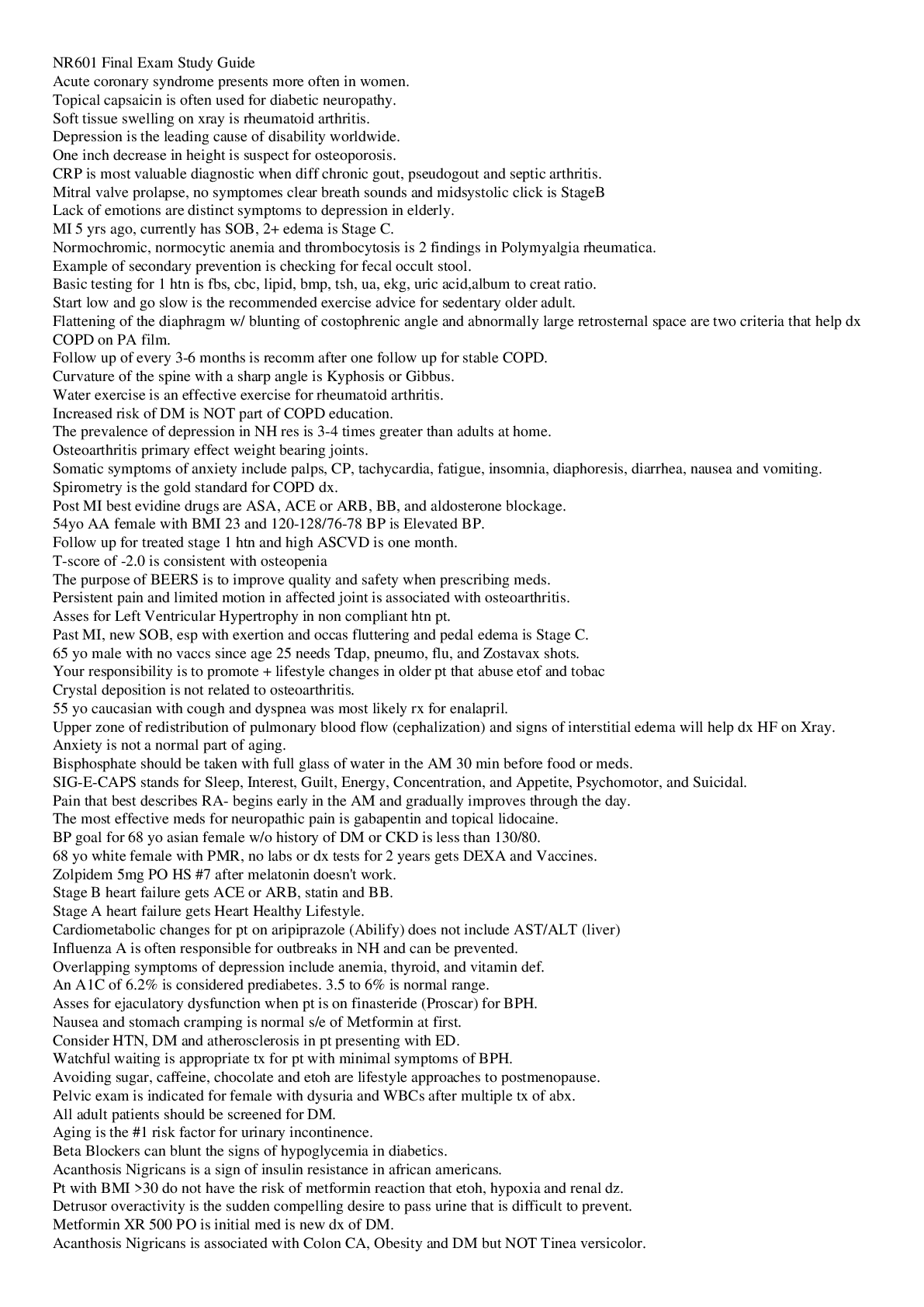
Reviews( 0 )
Document information
Connected school, study & course
About the document
Uploaded On
Jun 29, 2020
Number of pages
0
Written in
Additional information
This document has been written for:
Uploaded
Jun 29, 2020
Downloads
0
Views
99

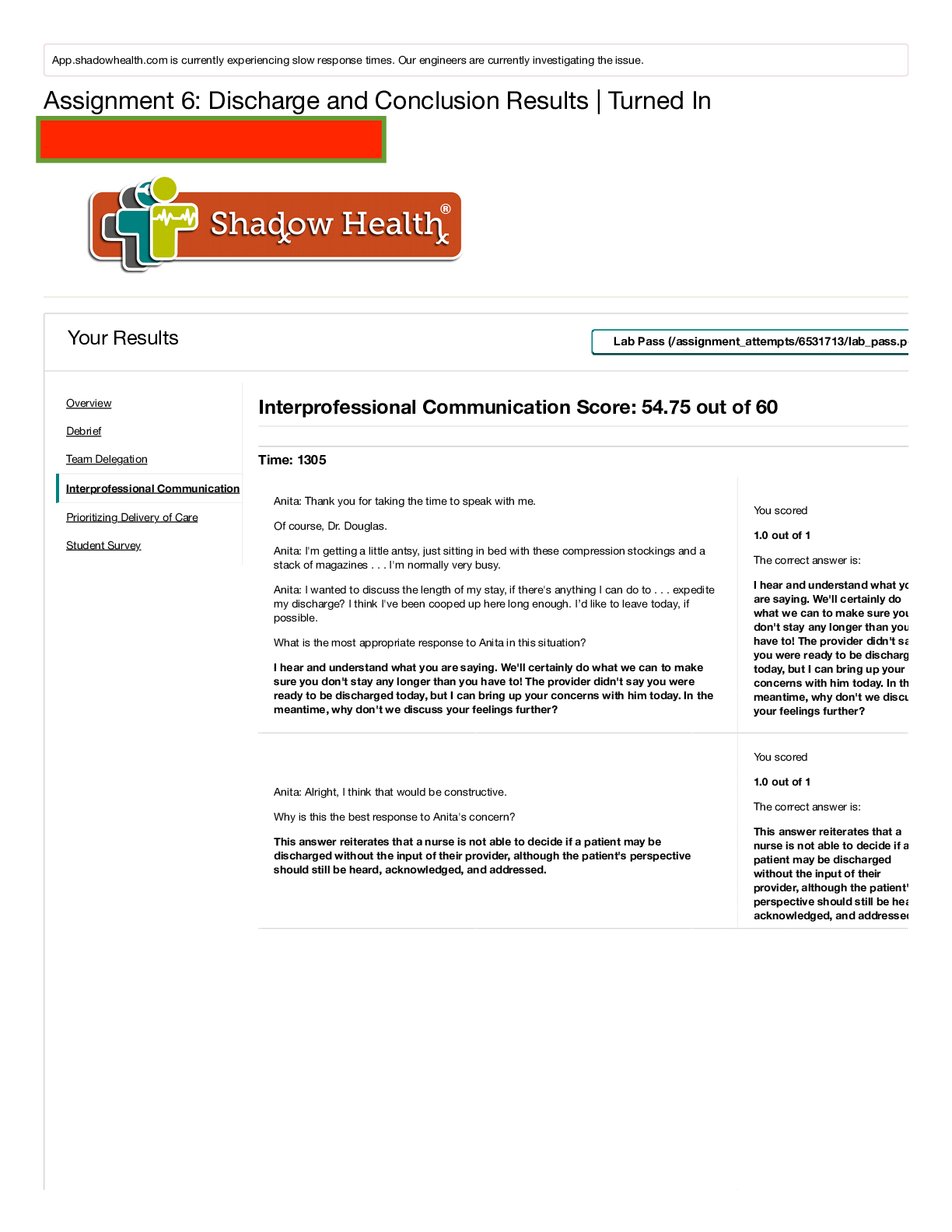
 Rasmussen College.png)

